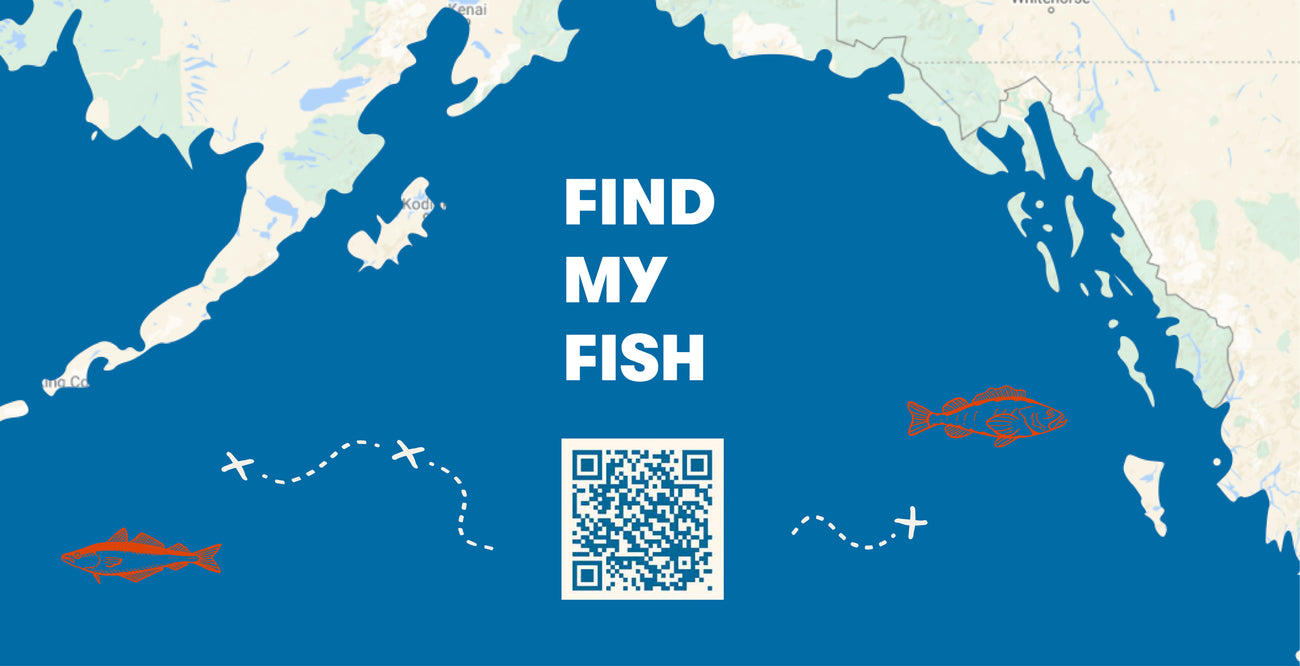
You should know where your fish was caught and its social and environmental impact.
Enter your Batch Date to trace your product:
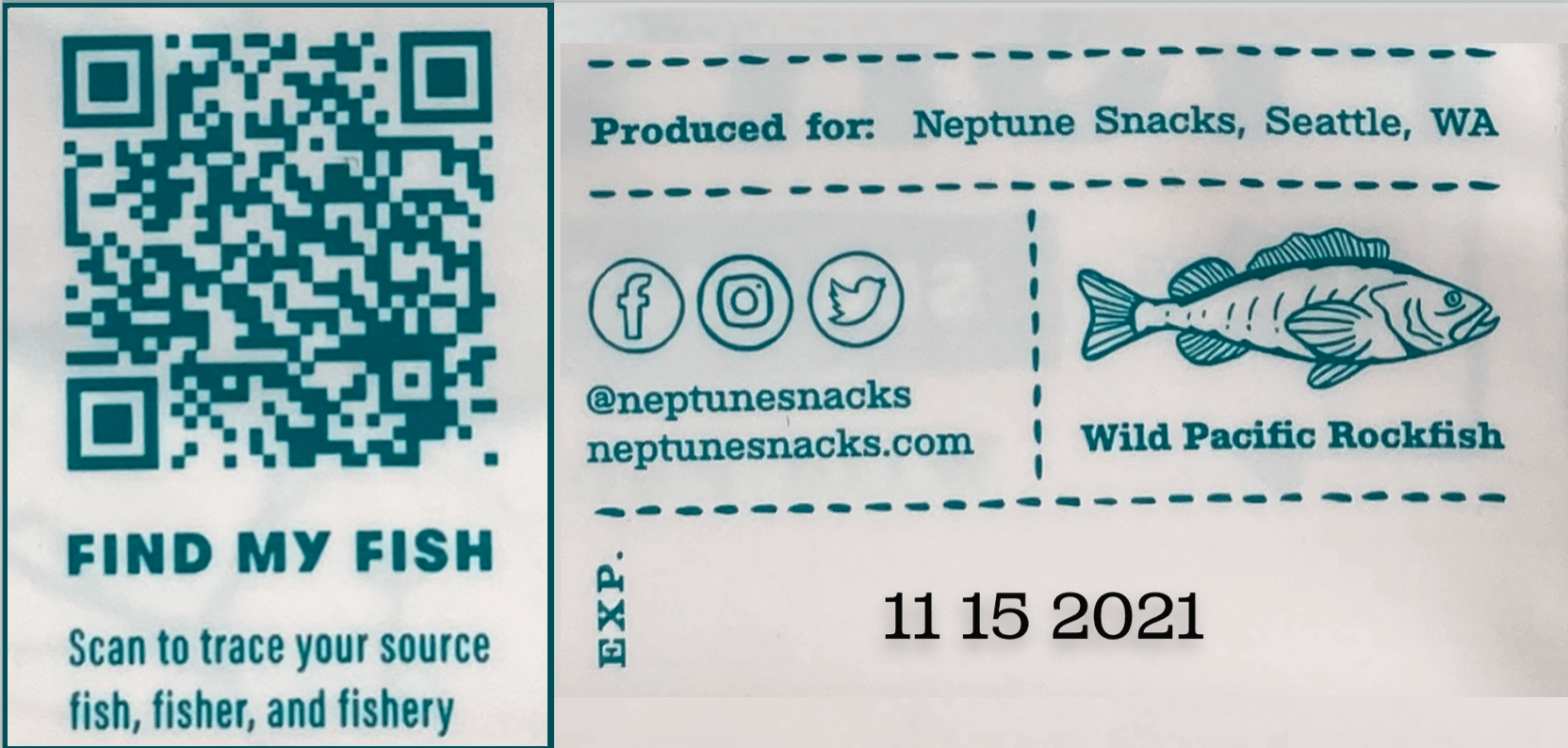
Currently Showing Batch Date 03/16/2022
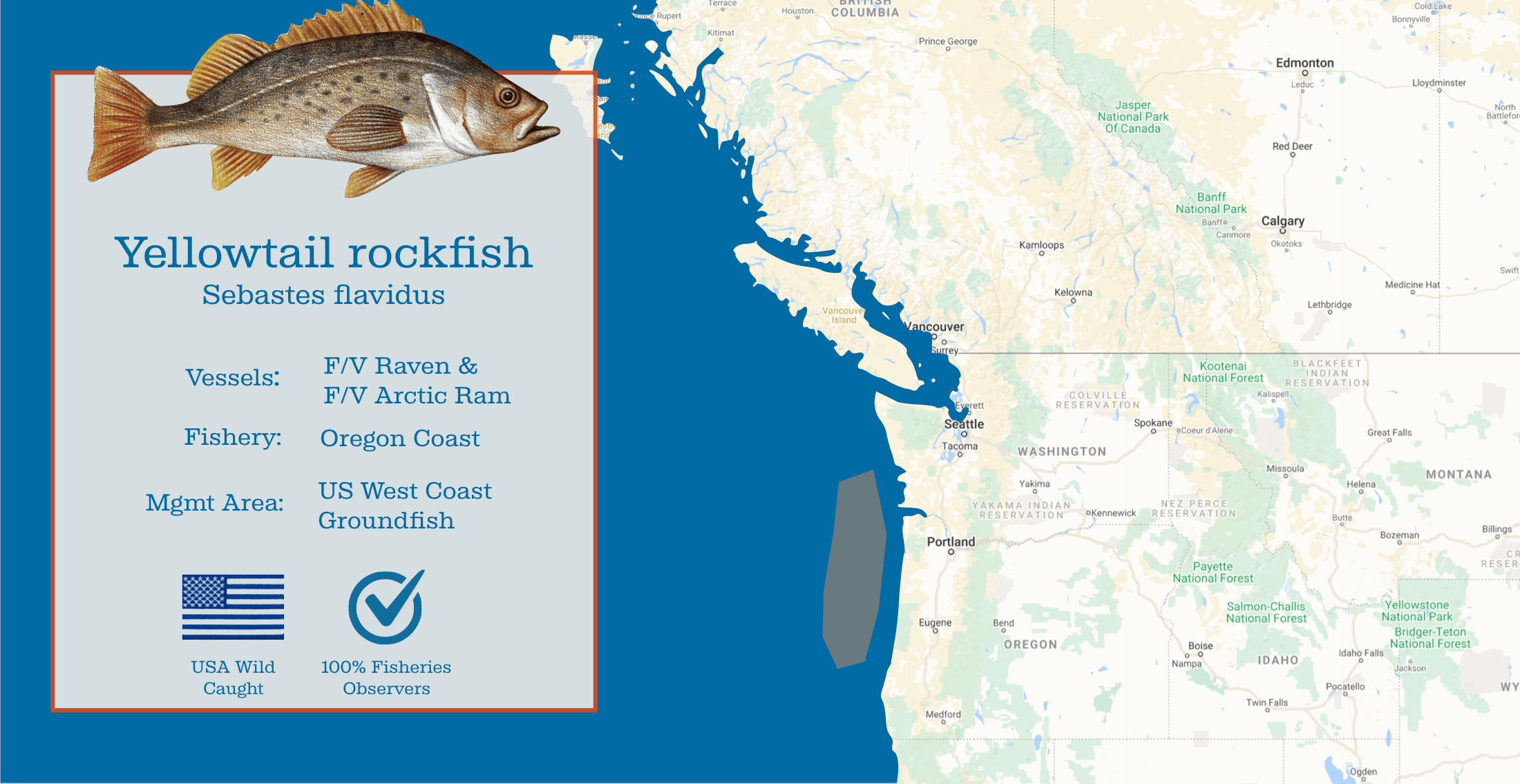
Fish: +−
Common Name: Yellowtail rockfish
Latin Name: Sebastes flavidus
Habitat: Yellowtail rockfish range from San Diego, California to the Aleutian Islands of Alaska and can be found from the surface to over 500 in depth. Yellowtail are a schooling fish that sometimes swim well off the bottom in large aggregations.
Size: Up to 26 inches
Taste: Up to 26 inches
Fisher: +−
Vessel(s): F/V Raven and F/V Arctic Ram
Fishery: +−
Caught: Oregon Coast, US West Coast Groundfish Fishery
Processed: Puyallup, WA
Summary:+−
Your jerky was made from “Best Choice” Yellowtail rockfish landed in US West Coast Groundfish Fishery. These fish were bycatch caught by several local mid-water trawl fishers targeting Pacific whiting, and recorded in the quota. This fishery has 100% Fisheries Observer requirements for boats fishing, ensuring accurate reporting and management. Some Widow and canary rockfish, which school with or near Yellowtail, are also part of this catch, and all three species are a part of the conservation and management success story in the US West Coast Groundfish fishery.
INTRO TO TRACEABILITY: FISHTRAX
The Fish Trax™ system is a leading-edge electronic fishery information platform that revolutionizes the way fisheries information is collected, analyzed and shared. Envisioned initially by fishermen and scientists to track important resource data, Fish Trax™ has now expanded to serve as a tool for the seafood industry, allowing managers, scientists, regulators, and marketers to collect data and collaborate on ways to improve sustainable management practices.
HOW DID WE CHOOSE OUR FISHERIES? SCIENCE!
Our source fisheries each tell a story about the seafood sustainability that exists, and which could exist across more of the world's wild and farmed seafood if we, as consumers, demand change.
The Rockfish is a little known rockstar of the US West Coast, and a true success story in fisheries management.
The name ‘Pacific rockfish’ describes family of abundant, sustainably-managed Sebastes species common from Southern California to the Pacific Northwest and the Gulf of Alaska. After being severely depleted as a result of poor management and overfishing in the 1980’s and 1990’s (to the point that the fishery was declared a federal disaster in 2000), a new management program began in 2011 to help West Coast fishermen stay within catch limits and to avoid vulnerable species and sensitive habitat. Through the hard work of scientists, policymakers, and the fishing community, populations have rebounded, fishermen are catching rockfish, and these species are now considered a sustainable choice. At the same time, sensitive ecological areas have been protected and bycatch has reduced dramatically along the West Coast, earning most species in the fishery a “Best Choice” or “Good Alternative” listing and prompting the the Marine Stewardship Council to certify 13 species of West Coast groundfish.
Now, here’s the rub: despite the fact that they are a rich source of high-quality, sustainable protein, rockfish are currently undervalued and underutilized. Consumer interest for this noble family of fishes has yet to bounce back. In fact, only 24% of the scientifically-based West Coast quota for Pacific rockfish is caught, largely because our local rockstars have been replaced by various foreign whitefish species. As a result, some fishing communities continue to struggle, but you can help bring this success story full circle when you make the right seafood choices.
Alaska is a poster child for effective fisheries management. The Wild Alaska Pollock we source is a regenerative ocean resource from the #2 MSC certified fishery on earth and has one-fifth the carbon footprint of leading plant-based burgers (and there is published data to prove this!), with zero freshwater, agricultural inputs, or land conversion needed to produce the protein. Stocks in the fishery are healthy and abundant. In fact, The Alaska pollock has been said to be "the largest remaining source of palatable fish in the world." 85% of the fishery biomass is left water each year as part of healthy management. This fishery has 100% Fisheries Observer requirements for boats fishing, ensuring accurate reporting and management.
Neptune Snacks uses this amazing wild-caught fish to make our delicious jerky in fulfillment of our mission, which is “to innovate and incite change in the seafood industry by building a healthy, sustainable relationship with the ocean". In our eyes, the story of West Coast groundfish should serve as a model for recovery, and it is our hope that rockfish jerky is just the beginning of sweeping change in seafood. You, the consumer, can demand traceable, sustainable, high-quality seafood and be the change you want to see in our oceans.
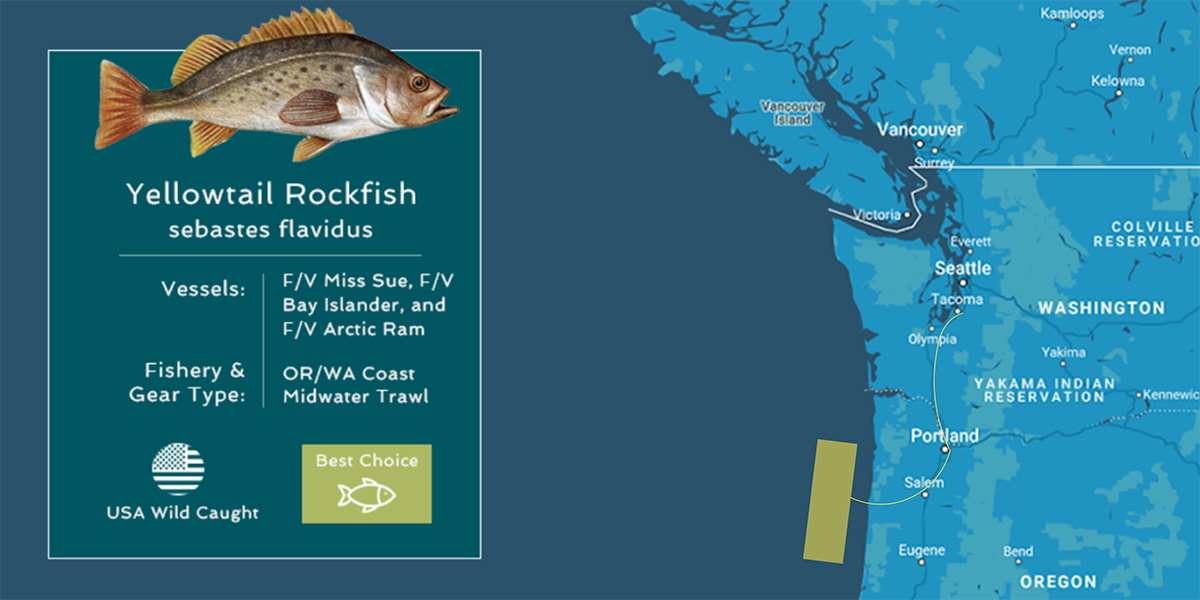
Fish: +−
Common Name: Yellowtail rockfish
Latin Name: Sebastes flavidus
Habitat: Yellowtail rockfish range from San Diego, California to the Aleutian Islands of Alaska and can be found from the surface to over 500 in depth. Yellowtail are a schooling fish that sometime swim well off the bottom in the thousands.
Size: Up to 26 inches
Taste: Medium-firm flesh and a mild taste
Fisher: +−
Vessels: F/V Miss Sue, F/V Bay Islander, and F/V Arctic Ram
Gear Type: Mid-water trawl - a fishing method that does not come into contact with the seabed and is not associated with damage to marine habitat.
Fishery: +−
Caught: OR / WA Coast
Landed: Newport, OR
Processed: Newport, OR
The West Coast Groundfish Fishery is a conservation management success story. After the fishery was declared a federal disaster following decades of poor management, fishers, regulators, scientists, conservationists, and groups like the Environmental Defense Fund (EDF) worked together toward recovery. The fishery has now been awarded MSC certification as sustainable and well managed and nearly all groundfish caught from CA to WA rank as “Best Choice” or “Good Alternative” by Monterey Bay Aquarium’s Seafood Watch Program. NOAA Fisheries and the Pacific Fishery Management Council oversee the management of 90+ species of groundfish in U.S. federal waters.
Summary:+−
Your jerky was made from “Best Choice” Yellowtail rockfish landed in Newport, Oregon. These fish were bycatch caught by several local mid-water trawl fishers targeting Pacific whiting. Some Widow rockfish, which school with or near Yellowtail, are also part of this catch. Yellowtail and Widow rockfish are a part of the conservation and management success story in the US West Coast Groundfish fishery.
INTRO TO TRACEABILITY: FISHTRAX
The Fish Trax™ system is a leading-edge electronic fishery information platform that revolutionizes the way fisheries information is collected, analyzed and shared. Envisioned initially by fishermen and scientists to track important resource data, Fish Trax™ has now expanded to serve as a tool for the seafood industry, allowing managers, scientists, regulators, and marketers to collect data and collaborate on ways to improve sustainable management practices.
HOW DID WE CHOOSE OUR FISHERIES? SCIENCE!
Our source fisheries each tell a story about the seafood sustainability that exists, and which could exist across more of the world's wild and farmed seafood if we, as consumers, demand change.
The Rockfish is a little known rockstar of the US West Coast, and a true success story in fisheries management.
The name ‘Pacific rockfish’ describes family of abundant, sustainably-managed Sebastes species common from Southern California to the Pacific Northwest and the Gulf of Alaska. After being severely depleted as a result of poor management and overfishing in the 1980’s and 1990’s (to the point that the fishery was declared a federal disaster in 2000), a new management program began in 2011 to help West Coast fishermen stay within catch limits and to avoid vulnerable species and sensitive habitat. Through the hard work of scientists, policymakers, and the fishing community, populations have rebounded, fishermen are catching rockfish, and these species are now considered a sustainable choice. At the same time, sensitive ecological areas have been protected and bycatch has reduced dramatically along the West Coast, earning most species in the fishery a “Best Choice” or “Good Alternative” listing and prompting the the Marine Stewardship Council to certify 13 species of West Coast groundfish.
Now, here’s the rub: despite the fact that they are a rich source of high-quality, sustainable protein, rockfish are currently undervalued and underutilized. Consumer interest for this noble family of fishes has yet to bounce back. In fact, only 24% of the scientifically-based West Coast quota for Pacific rockfish is caught, largely because our local rockstars have been replaced by various foreign whitefish species. As a result, some fishing communities continue to struggle, but you can help bring this success story full circle when you make the right seafood choices.
Alaska is a poster child for effective fisheries management. The Wild Alaska Pollock we source is a regenerative ocean resource from the #2 MSC certified fishery on earth and has one-fifth the carbon footprint of leading plant-based burgers (and there is published data to prove this!), with zero freshwater, agricultural inputs, or land conversion needed to produce the protein. Stocks in the fishery are healthy and abundant. In fact, The Alaska pollock has been said to be "the largest remaining source of palatable fish in the world." 85% of the fishery biomass is left water each year as part of healthy management. This fishery has 100% Fisheries Observer requirements for boats fishing, ensuring accurate reporting and management.
Neptune Snacks uses this amazing wild-caught fish to make our delicious jerky in fulfillment of our mission, which is “to innovate and incite change in the seafood industry by building a healthy, sustainable relationship with the ocean". In our eyes, the story of West Coast groundfish should serve as a model for recovery, and it is our hope that rockfish jerky is just the beginning of sweeping change in seafood. You, the consumer, can demand traceable, sustainable, high-quality seafood and be the change you want to see in our oceans.
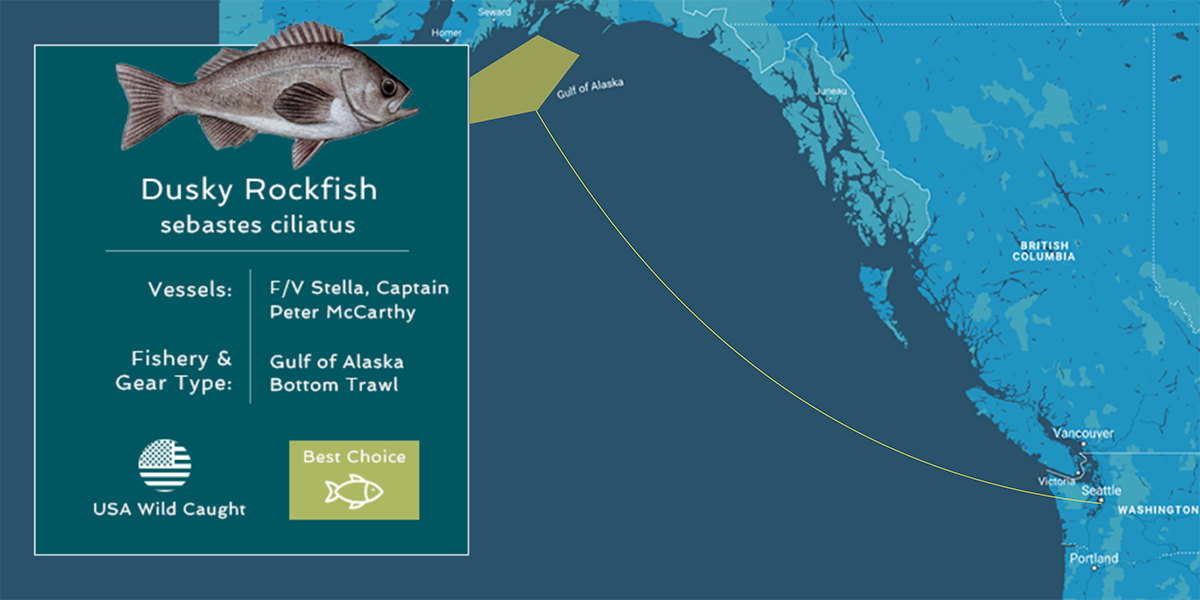
Fish: +−
Common Name: Dusky rockfish
Latin Name: Sebastes ciliatus
Habitat: Dusky are found along the North American West Coast from British Columbia to the Aleutian Islands. They are solitary, inhabiting steep rocky areas with shelter, commonly between 200 ft and 400 ft.
Size: Up to 18 inches
Taste: Medium-firm flesh and a mild to rich taste
Fisher: +−
Vessel: F/V Stella
Captain: Peter McCarthy
Gear Type: Bottom Trawl
Fishery: +−
Caught: Kodiak, Alaska
Landed: Kodiak, Alaska
Processed: Kodiak, Alaska
Many rockfish species caught in the Gulf of Alaska are rated as a “Best Choice”, as the stock is healthy, and current management is rated effective.
Summary:+−
Your jerky was made from Dusky rockfish and with several other co-schooling rockfish species caught as bycatch in the Alaskan Sablefish fishery. They have a mild, rich flavor and we put them toward their highest purpose as incidental catch. Dusky caught in the Gulf of Alaska are rated as a “Best Choice”, as the stock is healthy, and current management is rated effective.
INTRO TO TRACEABILITY: FISHTRAX
The Fish Trax™ system is a leading-edge electronic fishery information platform that revolutionizes the way fisheries information is collected, analyzed and shared. Envisioned initially by fishermen and scientists to track important resource data, Fish Trax™ has now expanded to serve as a tool for the seafood industry, allowing managers, scientists, regulators, and marketers to collect data and collaborate on ways to improve sustainable management practices.
HOW DID WE CHOOSE OUR FISHERIES? SCIENCE!
Our source fisheries each tell a story about the seafood sustainability that exists, and which could exist across more of the world's wild and farmed seafood if we, as consumers, demand change.
The Rockfish is a little known rockstar of the US West Coast, and a true success story in fisheries management.
The name ‘Pacific rockfish’ describes family of abundant, sustainably-managed Sebastes species common from Southern California to the Pacific Northwest and the Gulf of Alaska. After being severely depleted as a result of poor management and overfishing in the 1980’s and 1990’s (to the point that the fishery was declared a federal disaster in 2000), a new management program began in 2011 to help West Coast fishermen stay within catch limits and to avoid vulnerable species and sensitive habitat. Through the hard work of scientists, policymakers, and the fishing community, populations have rebounded, fishermen are catching rockfish, and these species are now considered a sustainable choice. At the same time, sensitive ecological areas have been protected and bycatch has reduced dramatically along the West Coast, earning most species in the fishery a “Best Choice” or “Good Alternative” listing and prompting the the Marine Stewardship Council to certify 13 species of West Coast groundfish.
Now, here’s the rub: despite the fact that they are a rich source of high-quality, sustainable protein, rockfish are currently undervalued and underutilized. Consumer interest for this noble family of fishes has yet to bounce back. In fact, only 24% of the scientifically-based West Coast quota for Pacific rockfish is caught, largely because our local rockstars have been replaced by various foreign whitefish species. As a result, some fishing communities continue to struggle, but you can help bring this success story full circle when you make the right seafood choices.
Alaska is a poster child for effective fisheries management. The Wild Alaska Pollock we source is a regenerative ocean resource from the #2 MSC certified fishery on earth and has one-fifth the carbon footprint of leading plant-based burgers (and there is published data to prove this!), with zero freshwater, agricultural inputs, or land conversion needed to produce the protein. Stocks in the fishery are healthy and abundant. In fact, The Alaska pollock has been said to be "the largest remaining source of palatable fish in the world." 85% of the fishery biomass is left water each year as part of healthy management. This fishery has 100% Fisheries Observer requirements for boats fishing, ensuring accurate reporting and management.
Neptune Snacks uses this amazing wild-caught fish to make our delicious jerky in fulfillment of our mission, which is “to innovate and incite change in the seafood industry by building a healthy, sustainable relationship with the ocean". In our eyes, the story of West Coast groundfish should serve as a model for recovery, and it is our hope that rockfish jerky is just the beginning of sweeping change in seafood. You, the consumer, can demand traceable, sustainable, high-quality seafood and be the change you want to see in our oceans.
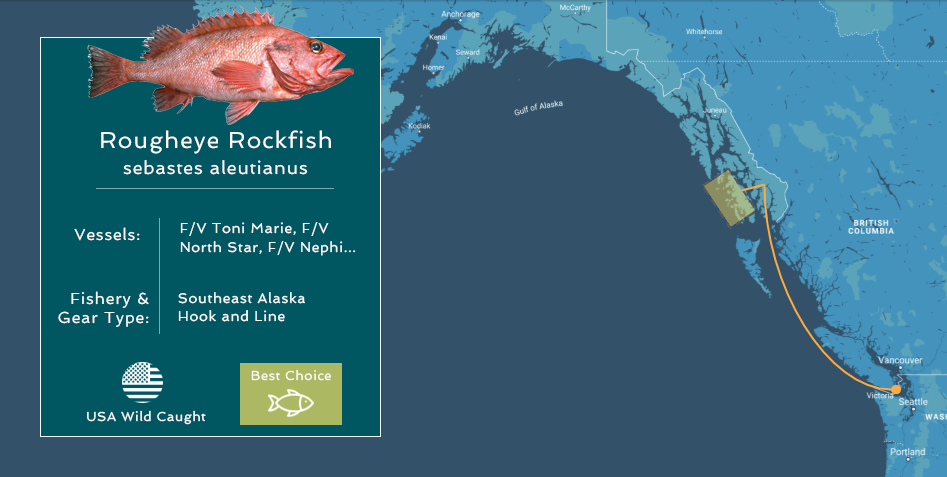
Fish: +−
Common Name: Rougheye rockfish
Latin Name: Sebastes aleutianus
Habitat: Rougheye rockfish typically live at depths between 500 and 2,000 feet, preferring rocky bottom and outcroppings surrounded softer seafloor. They eat a diverse diet, including smaller fish and crustaceans like shrimp and crab.
Size: Up to 38 inches, 14 pounds
Taste: Medium-firm flesh, rich taste
Fisher: +−
Vessel(s): More than a few fishers lent a hand in landing this catch! F/V Toni Marie, F/V North Star, F/V Nephi, F/V Arlice, F/V Carol Anne, F/V Breakers Edge, F/V Bronze Maiden, F/V Elizabeth S, F/V Nakwasina, F/V Northern Fury, F/V Randa Rose, F/V Trumpeter, F/V Vindacator, F/V Western Queen, F/V Trendsetter, F/V Sylvia, F/V Teasha OR, F/V Emily Nicole, F/V Rita, and F/V Venus.
Fishery: +−
Caught: Southeast Alaska
Landed: Wrangell, Alaska
Processed: Wrangell, Alaska
Many rockfish species are considered abundant in the Many rockfish species caught in the Gulf of Alaska are rated as a “Best Choice”, as the stock is healthy, and current management is rated effective.
Summary:+−
Your jerky was made from “Best Choice” Rougheye rockfish and several other co-schooling rockfish species caught as bycatch in the hook-and-line Alaskan Halibut fishery. Like most rockfish, Rougheye have a mild, rich flavor and we put them toward their highest purpose as incidental catch. Rougheye landed by hook and line in Alaska are green listed because management is considered effective policies around the fishery are being developed to protect the ecosystem.
INTRO TO TRACEABILITY: FISHTRAX
The Fish Trax™ system is a leading-edge electronic fishery information platform that revolutionizes the way fisheries information is collected, analyzed and shared. Envisioned initially by fishermen and scientists to track important resource data, Fish Trax™ has now expanded to serve as a tool for the seafood industry, allowing managers, scientists, regulators, and marketers to collect data and collaborate on ways to improve sustainable management practices.
HOW DID WE CHOOSE OUR FISHERIES? SCIENCE!
Our source fisheries each tell a story about the seafood sustainability that exists, and which could exist across more of the world's wild and farmed seafood if we, as consumers, demand change.
The Rockfish is a little known rockstar of the US West Coast, and a true success story in fisheries management.
The name ‘Pacific rockfish’ describes family of abundant, sustainably-managed Sebastes species common from Southern California to the Pacific Northwest and the Gulf of Alaska. After being severely depleted as a result of poor management and overfishing in the 1980’s and 1990’s (to the point that the fishery was declared a federal disaster in 2000), a new management program began in 2011 to help West Coast fishermen stay within catch limits and to avoid vulnerable species and sensitive habitat. Through the hard work of scientists, policymakers, and the fishing community, populations have rebounded, fishermen are catching rockfish, and these species are now considered a sustainable choice. At the same time, sensitive ecological areas have been protected and bycatch has reduced dramatically along the West Coast, earning most species in the fishery a “Best Choice” or “Good Alternative” listing and prompting the the Marine Stewardship Council to certify 13 species of West Coast groundfish.
Now, here’s the rub: despite the fact that they are a rich source of high-quality, sustainable protein, rockfish are currently undervalued and underutilized. Consumer interest for this noble family of fishes has yet to bounce back. In fact, only 24% of the scientifically-based West Coast quota for Pacific rockfish is caught, largely because our local rockstars have been replaced by various foreign whitefish species. As a result, some fishing communities continue to struggle, but you can help bring this success story full circle when you make the right seafood choices.
Alaska is a poster child for effective fisheries management. The Wild Alaska Pollock we source is a regenerative ocean resource from the #2 MSC certified fishery on earth and has one-fifth the carbon footprint of leading plant-based burgers (and there is published data to prove this!), with zero freshwater, agricultural inputs, or land conversion needed to produce the protein. Stocks in the fishery are healthy and abundant. In fact, The Alaska pollock has been said to be "the largest remaining source of palatable fish in the world." 85% of the fishery biomass is left water each year as part of healthy management. This fishery has 100% Fisheries Observer requirements for boats fishing, ensuring accurate reporting and management.
Neptune Snacks uses this amazing wild-caught fish to make our delicious jerky in fulfillment of our mission, which is “to innovate and incite change in the seafood industry by building a healthy, sustainable relationship with the ocean". In our eyes, the story of West Coast groundfish should serve as a model for recovery, and it is our hope that rockfish jerky is just the beginning of sweeping change in seafood. You, the consumer, can demand traceable, sustainable, high-quality seafood and be the change you want to see in our oceans.
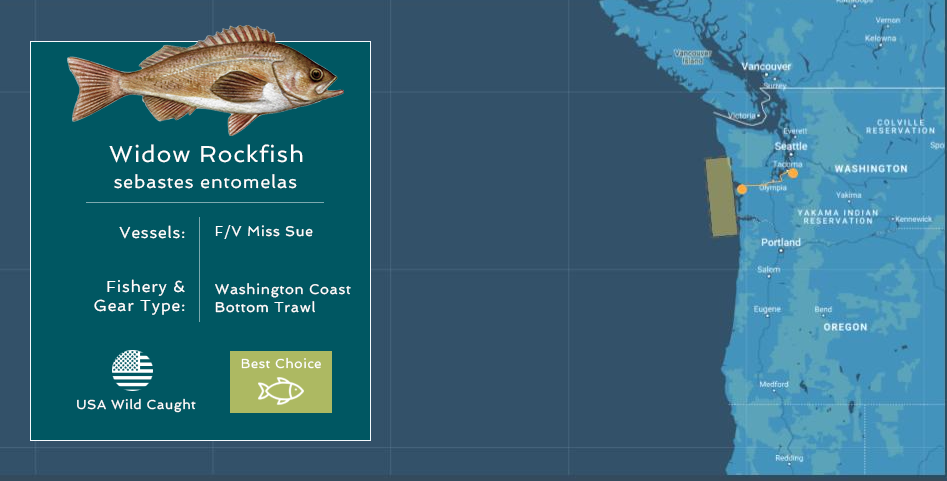
Fish: +−
Common Name: Widow rockfish
Latin Name: Sebastes entomelas
Habitat: Widow rockfish typically live at depths between 500 and 700 feet, preferring rocky bottom and outcroppings surrounded softer seafloor. They eat a diverse diet, including smaller fish and crustaceans like shrimp, krill, small fish, and crab.
Size: Up to 24 inches, 14 pounds
Taste: Medium-firm flesh, rich taste
Fisher: +−
Vessel(s): F/V: Miss Sue
Fishery: +−
Caught: Washington Coast
Landed: Westport, WA
Processed: Westport, WA
This fishery and species is MSC certified and stocks continue to improve under the new management system. Many rockfish species are considered abundant in the waters off the Washington Coast. Many rockfish species caught in the Washington Coast are rated as a “Best Choice”, as the stock is healthy, and current management is rated effective.
Summary:+−
Your jerky was made from “Best Choice” Widow rockfish caught as bycatch in the trawl-caught Washington Coast whiting fishery. Like most rockfish, Widow have a mild, rich flavor and we put them toward their highest purpose as incidental catch. Widow landed via trawl-caught in Washington Coast are green listed because management is considered effective policies around the fishery are being developed to protect the ecosystem.
INTRO TO TRACEABILITY: FISHTRAX
The Fish Trax™ system is a leading-edge electronic fishery information platform that revolutionizes the way fisheries information is collected, analyzed and shared. Envisioned initially by fishermen and scientists to track important resource data, Fish Trax™ has now expanded to serve as a tool for the seafood industry, allowing managers, scientists, regulators, and marketers to collect data and collaborate on ways to improve sustainable management practices.
HOW DID WE CHOOSE OUR FISHERIES? SCIENCE!
Our source fisheries each tell a story about the seafood sustainability that exists, and which could exist across more of the world's wild and farmed seafood if we, as consumers, demand change.
The Rockfish is a little known rockstar of the US West Coast, and a true success story in fisheries management.
The name ‘Pacific rockfish’ describes family of abundant, sustainably-managed Sebastes species common from Southern California to the Pacific Northwest and the Gulf of Alaska. After being severely depleted as a result of poor management and overfishing in the 1980’s and 1990’s (to the point that the fishery was declared a federal disaster in 2000), a new management program began in 2011 to help West Coast fishermen stay within catch limits and to avoid vulnerable species and sensitive habitat. Through the hard work of scientists, policymakers, and the fishing community, populations have rebounded, fishermen are catching rockfish, and these species are now considered a sustainable choice. At the same time, sensitive ecological areas have been protected and bycatch has reduced dramatically along the West Coast, earning most species in the fishery a “Best Choice” or “Good Alternative” listing and prompting the the Marine Stewardship Council to certify 13 species of West Coast groundfish.
Now, here’s the rub: despite the fact that they are a rich source of high-quality, sustainable protein, rockfish are currently undervalued and underutilized. Consumer interest for this noble family of fishes has yet to bounce back. In fact, only 24% of the scientifically-based West Coast quota for Pacific rockfish is caught, largely because our local rockstars have been replaced by various foreign whitefish species. As a result, some fishing communities continue to struggle, but you can help bring this success story full circle when you make the right seafood choices.
Alaska is a poster child for effective fisheries management. The Wild Alaska Pollock we source is a regenerative ocean resource from the #2 MSC certified fishery on earth and has one-fifth the carbon footprint of leading plant-based burgers (and there is published data to prove this!), with zero freshwater, agricultural inputs, or land conversion needed to produce the protein. Stocks in the fishery are healthy and abundant. In fact, The Alaska pollock has been said to be "the largest remaining source of palatable fish in the world." 85% of the fishery biomass is left water each year as part of healthy management. This fishery has 100% Fisheries Observer requirements for boats fishing, ensuring accurate reporting and management.
Neptune Snacks uses this amazing wild-caught fish to make our delicious jerky in fulfillment of our mission, which is “to innovate and incite change in the seafood industry by building a healthy, sustainable relationship with the ocean". In our eyes, the story of West Coast groundfish should serve as a model for recovery, and it is our hope that rockfish jerky is just the beginning of sweeping change in seafood. You, the consumer, can demand traceable, sustainable, high-quality seafood and be the change you want to see in our oceans.

Fish: +−
Common Name: Widow rockfish
Latin Name: Sebastes entomelas
Habitat: Widow rockfish typically live at depths between 500 and 700 feet, preferring rocky bottom and outcroppings surrounded softer seafloor. They eat a diverse diet, including smaller fish and crustaceans like shrimp, krill, small fish, and crab.
Size: Up to 24 inches, 14 pounds
Taste: Medium-firm flesh, rich taste
Fisher: +−
Vessel(s): F/V: Miss Sue, F/V Excalibur
Fishery: +−
Caught: Washington Coast
Landed: Westport, WA
Processed: Westport, WA
This fishery and species is MSC certified and stocks continue to improve under the new management system. Many rockfish species are considered abundant in the waters off the Washington Coast. Many rockfish species caught in the Washington Coast are rated as a “Best Choice”, as the stock is healthy, and current management is rated effective.
Summary:+−
Your jerky was made from “Best Choice” Widow rockfish caught as bycatch in the trawl-caught Washington Coast whiting fishery. Like most rockfish, Widow have a mild, rich flavor and we put them toward their highest purpose as incidental catch. Widow landed via trawl-caught in Washington Coast are green listed because management is considered effective policies around the fishery are being developed to protect the ecosystem. These bycatch landings are part of the scientifically-based quota.
INTRO TO TRACEABILITY: FISHTRAX
The Fish Trax™ system is a leading-edge electronic fishery information platform that revolutionizes the way fisheries information is collected, analyzed and shared. Envisioned initially by fishermen and scientists to track important resource data, Fish Trax™ has now expanded to serve as a tool for the seafood industry, allowing managers, scientists, regulators, and marketers to collect data and collaborate on ways to improve sustainable management practices.
HOW DID WE CHOOSE OUR FISHERIES? SCIENCE!
Our source fisheries each tell a story about the seafood sustainability that exists, and which could exist across more of the world's wild and farmed seafood if we, as consumers, demand change.
The Rockfish is a little known rockstar of the US West Coast, and a true success story in fisheries management.
The name ‘Pacific rockfish’ describes family of abundant, sustainably-managed Sebastes species common from Southern California to the Pacific Northwest and the Gulf of Alaska. After being severely depleted as a result of poor management and overfishing in the 1980’s and 1990’s (to the point that the fishery was declared a federal disaster in 2000), a new management program began in 2011 to help West Coast fishermen stay within catch limits and to avoid vulnerable species and sensitive habitat. Through the hard work of scientists, policymakers, and the fishing community, populations have rebounded, fishermen are catching rockfish, and these species are now considered a sustainable choice. At the same time, sensitive ecological areas have been protected and bycatch has reduced dramatically along the West Coast, earning most species in the fishery a “Best Choice” or “Good Alternative” listing and prompting the the Marine Stewardship Council to certify 13 species of West Coast groundfish.
Now, here’s the rub: despite the fact that they are a rich source of high-quality, sustainable protein, rockfish are currently undervalued and underutilized. Consumer interest for this noble family of fishes has yet to bounce back. In fact, only 24% of the scientifically-based West Coast quota for Pacific rockfish is caught, largely because our local rockstars have been replaced by various foreign whitefish species. As a result, some fishing communities continue to struggle, but you can help bring this success story full circle when you make the right seafood choices.
Alaska is a poster child for effective fisheries management. The Wild Alaska Pollock we source is a regenerative ocean resource from the #2 MSC certified fishery on earth and has one-fifth the carbon footprint of leading plant-based burgers (and there is published data to prove this!), with zero freshwater, agricultural inputs, or land conversion needed to produce the protein. Stocks in the fishery are healthy and abundant. In fact, The Alaska pollock has been said to be "the largest remaining source of palatable fish in the world." 85% of the fishery biomass is left water each year as part of healthy management. This fishery has 100% Fisheries Observer requirements for boats fishing, ensuring accurate reporting and management.
Neptune Snacks uses this amazing wild-caught fish to make our delicious jerky in fulfillment of our mission, which is “to innovate and incite change in the seafood industry by building a healthy, sustainable relationship with the ocean". In our eyes, the story of West Coast groundfish should serve as a model for recovery, and it is our hope that rockfish jerky is just the beginning of sweeping change in seafood. You, the consumer, can demand traceable, sustainable, high-quality seafood and be the change you want to see in our oceans.
Please select your flavor for this batch:
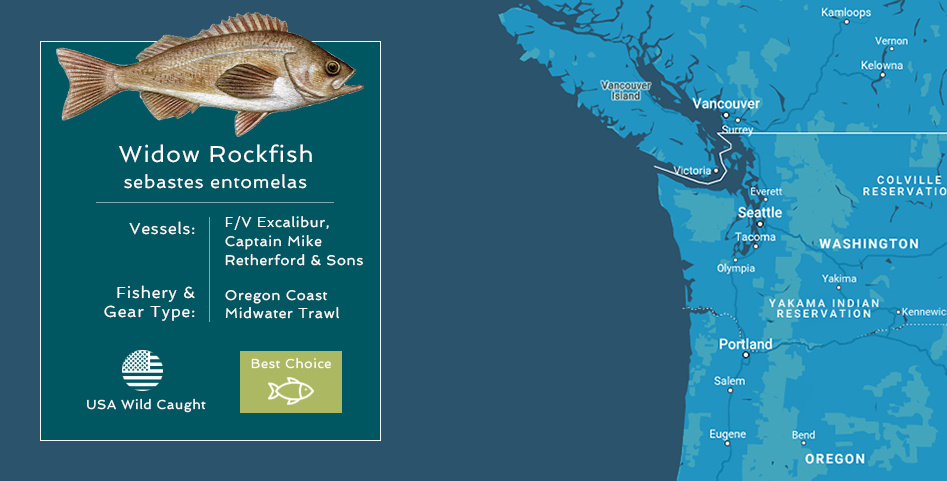
Fish: +−
Common Name: Widow rockfish
Latin Name: Sebastes entomelas
Habitat: Widow rockfish typically live at depths between 500 and 700 feet, preferring rocky bottom and outcroppings surrounded softer seafloor. They eat a diverse diet, including smaller fish and crustaceans like shrimp, krill, small fish, and crab.
Size: Up to 24 inches, 14 pounds
Taste: Medium-firm flesh, rich taste
Fisher: +−
Vessel(s): F/V Excalibur, Captain Mike Retherford & Sons
Fishery: +−
Caught: Oregon Coast
Landed: Newport, OR
Processed: Newport, OR
This fishery and species is MSC certified and stocks continue to improve under the new management system. Many rockfish species are considered abundant in the waters off the Oregon Coast. Many rockfish species caught in the Oregon Coast are rated as a “Best Choice”, as the stock is healthy, and current management is rated effective.
Summary:+−
Your jerky was made from “Best Choice” Widow rockfish caught as bycatch in the trawl-caught Washington Coast. We sourced cuts and sizes of premium fillets that did. Like most rockfish, Widow have a mild, rich flavor and we put them toward their highest purpose. Widow landed via trawl-caught in Washington Coast are green listed because management is considered effective policies around the fishery are being developed to protect the ecosystem. These bycatch landings are part of the scientifically-based quota.
INTRO TO TRACEABILITY: FISHTRAX
The Fish Trax™ system is a leading-edge electronic fishery information platform that revolutionizes the way fisheries information is collected, analyzed and shared. Envisioned initially by fishermen and scientists to track important resource data, Fish Trax™ has now expanded to serve as a tool for the seafood industry, allowing managers, scientists, regulators, and marketers to collect data and collaborate on ways to improve sustainable management practices.
HOW DID WE CHOOSE OUR FISHERIES? SCIENCE!
Our source fisheries each tell a story about the seafood sustainability that exists, and which could exist across more of the world's wild and farmed seafood if we, as consumers, demand change.
The Rockfish is a little known rockstar of the US West Coast, and a true success story in fisheries management.
The name ‘Pacific rockfish’ describes family of abundant, sustainably-managed Sebastes species common from Southern California to the Pacific Northwest and the Gulf of Alaska. After being severely depleted as a result of poor management and overfishing in the 1980’s and 1990’s (to the point that the fishery was declared a federal disaster in 2000), a new management program began in 2011 to help West Coast fishermen stay within catch limits and to avoid vulnerable species and sensitive habitat. Through the hard work of scientists, policymakers, and the fishing community, populations have rebounded, fishermen are catching rockfish, and these species are now considered a sustainable choice. At the same time, sensitive ecological areas have been protected and bycatch has reduced dramatically along the West Coast, earning most species in the fishery a “Best Choice” or “Good Alternative” listing and prompting the the Marine Stewardship Council to certify 13 species of West Coast groundfish.
Now, here’s the rub: despite the fact that they are a rich source of high-quality, sustainable protein, rockfish are currently undervalued and underutilized. Consumer interest for this noble family of fishes has yet to bounce back. In fact, only 24% of the scientifically-based West Coast quota for Pacific rockfish is caught, largely because our local rockstars have been replaced by various foreign whitefish species. As a result, some fishing communities continue to struggle, but you can help bring this success story full circle when you make the right seafood choices.
Alaska is a poster child for effective fisheries management. The Wild Alaska Pollock we source is a regenerative ocean resource from the #2 MSC certified fishery on earth and has one-fifth the carbon footprint of leading plant-based burgers (and there is published data to prove this!), with zero freshwater, agricultural inputs, or land conversion needed to produce the protein. Stocks in the fishery are healthy and abundant. In fact, The Alaska pollock has been said to be "the largest remaining source of palatable fish in the world." 85% of the fishery biomass is left water each year as part of healthy management. This fishery has 100% Fisheries Observer requirements for boats fishing, ensuring accurate reporting and management.
Neptune Snacks uses this amazing wild-caught fish to make our delicious jerky in fulfillment of our mission, which is “to innovate and incite change in the seafood industry by building a healthy, sustainable relationship with the ocean". In our eyes, the story of West Coast groundfish should serve as a model for recovery, and it is our hope that rockfish jerky is just the beginning of sweeping change in seafood. You, the consumer, can demand traceable, sustainable, high-quality seafood and be the change you want to see in our oceans.
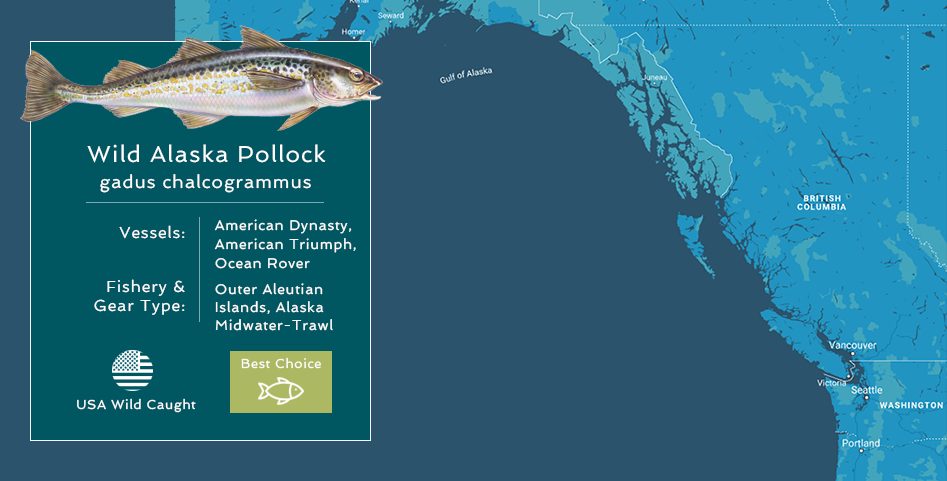
Fish: +−
Common Name: Wild Alaska Pollock
Latin Name: Gadus chalcogrammus
Habitat: Alaska Pollock are a relatively fast-growing and short-lived species, currently representing a major biological component of the Bering Sea ecosystem. Alaska pollock dive to various depths, following diel vertical migration in pursuit of food, daily and seasonally. The species is one of the most abundant fish in Alaskan waters.
Size: Up to 20 inches, 2 pounds
Taste: Medium-firm flesh, rich taste
Fisher: +−
Vessel(s): American Dynasty, American Triumph, Ocean Rover
Fishery: +−
Caught: Outer Aleutian Islands, Alaska
Landed: Dutch Harbor, AK
Processed: At Sea
This fishery and species is MSC certified and stocks are healthy and abundant. In fact, The Alaska pollock has been said to be "the largest remaining source of palatable fish in the world." 85% of the fishery biomass is left in the water as part of healthy management.
Summary:+−
Your jerky was made from Wild Alaska Pollock from the pristine waters of the southwestern Aleutian Islands. Alaska Pollock has a mild, clean flavor profile and a choice texture. This fishery has earned distinction as the #1 rated MSC Certified fishery in the world based on effective policy, low bycatch, and other environmental metrics. The Alaska pollock has been said to be "the largest remaining source of palatable fish in the world."
INTRO TO TRACEABILITY: FISHTRAX
The Fish Trax™ system is a leading-edge electronic fishery information platform that revolutionizes the way fisheries information is collected, analyzed and shared. Envisioned initially by fishermen and scientists to track important resource data, Fish Trax™ has now expanded to serve as a tool for the seafood industry, allowing managers, scientists, regulators, and marketers to collect data and collaborate on ways to improve sustainable management practices.
HOW DID WE CHOOSE OUR FISHERIES? SCIENCE!
Our source fisheries each tell a story about the seafood sustainability that exists, and which could exist across more of the world's wild and farmed seafood if we, as consumers, demand change.
The Rockfish is a little known rockstar of the US West Coast, and a true success story in fisheries management.
The name ‘Pacific rockfish’ describes family of abundant, sustainably-managed Sebastes species common from Southern California to the Pacific Northwest and the Gulf of Alaska. After being severely depleted as a result of poor management and overfishing in the 1980’s and 1990’s (to the point that the fishery was declared a federal disaster in 2000), a new management program began in 2011 to help West Coast fishermen stay within catch limits and to avoid vulnerable species and sensitive habitat. Through the hard work of scientists, policymakers, and the fishing community, populations have rebounded, fishermen are catching rockfish, and these species are now considered a sustainable choice. At the same time, sensitive ecological areas have been protected and bycatch has reduced dramatically along the West Coast, earning most species in the fishery a “Best Choice” or “Good Alternative” listing and prompting the the Marine Stewardship Council to certify 13 species of West Coast groundfish.
Now, here’s the rub: despite the fact that they are a rich source of high-quality, sustainable protein, rockfish are currently undervalued and underutilized. Consumer interest for this noble family of fishes has yet to bounce back. In fact, only 24% of the scientifically-based West Coast quota for Pacific rockfish is caught, largely because our local rockstars have been replaced by various foreign whitefish species. As a result, some fishing communities continue to struggle, but you can help bring this success story full circle when you make the right seafood choices.
Alaska is a poster child for effective fisheries management. The Wild Alaska Pollock we source is a regenerative ocean resource from the #2 MSC certified fishery on earth and has one-fifth the carbon footprint of leading plant-based burgers (and there is published data to prove this!), with zero freshwater, agricultural inputs, or land conversion needed to produce the protein. Stocks in the fishery are healthy and abundant. In fact, The Alaska pollock has been said to be "the largest remaining source of palatable fish in the world." 85% of the fishery biomass is left water each year as part of healthy management. This fishery has 100% Fisheries Observer requirements for boats fishing, ensuring accurate reporting and management.
Neptune Snacks uses this amazing wild-caught fish to make our delicious jerky in fulfillment of our mission, which is “to innovate and incite change in the seafood industry by building a healthy, sustainable relationship with the ocean". In our eyes, the story of West Coast groundfish should serve as a model for recovery, and it is our hope that rockfish jerky is just the beginning of sweeping change in seafood. You, the consumer, can demand traceable, sustainable, high-quality seafood and be the change you want to see in our oceans.
Please select your flavor for this batch:
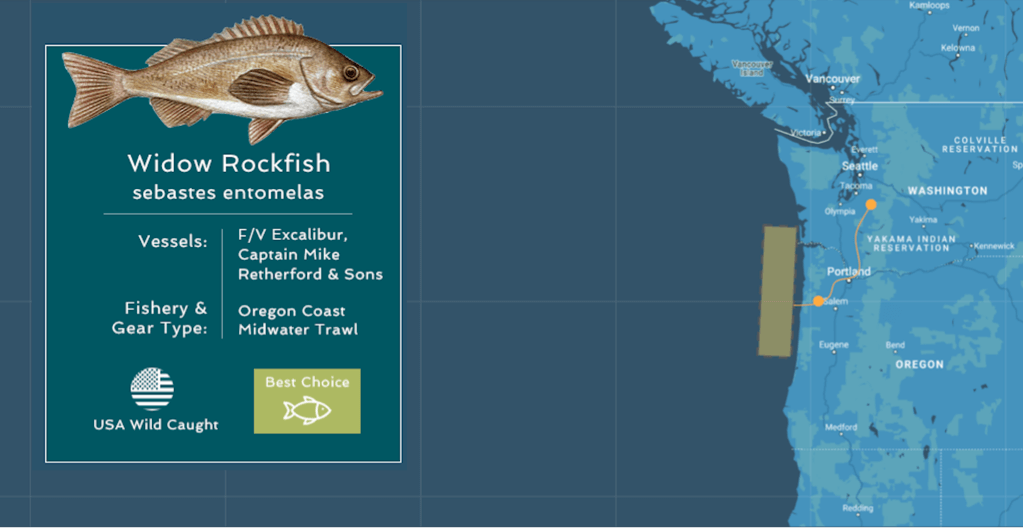
Fish: +−
Common Name: Widow rockfish
Latin Name: Sebastes entomelas
Habitat: Widow rockfish typically live at depths between 500 and 700 feet, preferring rocky bottom and outcroppings surrounded softer seafloor. They eat a diverse diet, including smaller fish and crustaceans like shrimp, krill, small fish, and crab.
Size: Up to 24 inches, 14 pounds
Taste: Medium-firm flesh, rich taste
Fisher: +−
Vessel(s): F/V Excalibur, Captain Mike Retherford & Sons
Fishery: +−
Caught: Oregon Coast
Landed: Newport, Oregon
Processed: Newport, Oregon
This fishery and species is MSC certified and stocks continue to improve under the new management system. Many rockfish species are considered abundant in the waters off the Washington Coast. Many rockfish species caught in the Washington Coast are rated as a “Best Choice”, as the stock is healthy, and current management is rated effective.
Summary:+−
Your jerky was made from “Best Choice” Widow rockfish caught as bycatch in the trawl-caught Washington Coast. We sourced cuts and sizes of premium fillets that did. Like most rockfish, Widow have a mild, rich flavor and we put them toward their highest purpose. Widow landed via trawl-caught in Washington Coast are green listed because management is considered effective policies around the fishery are being developed to protect the ecosystem. These bycatch landings are part of the scientifically-based quota.
INTRO TO TRACEABILITY: FISHTRAX
The Fish Trax™ system is a leading-edge electronic fishery information platform that revolutionizes the way fisheries information is collected, analyzed and shared. Envisioned initially by fishermen and scientists to track important resource data, Fish Trax™ has now expanded to serve as a tool for the seafood industry, allowing managers, scientists, regulators, and marketers to collect data and collaborate on ways to improve sustainable management practices.
HOW DID WE CHOOSE OUR FISHERIES? SCIENCE!
Our source fisheries each tell a story about the seafood sustainability that exists, and which could exist across more of the world's wild and farmed seafood if we, as consumers, demand change.
The Rockfish is a little known rockstar of the US West Coast, and a true success story in fisheries management.
The name ‘Pacific rockfish’ describes family of abundant, sustainably-managed Sebastes species common from Southern California to the Pacific Northwest and the Gulf of Alaska. After being severely depleted as a result of poor management and overfishing in the 1980’s and 1990’s (to the point that the fishery was declared a federal disaster in 2000), a new management program began in 2011 to help West Coast fishermen stay within catch limits and to avoid vulnerable species and sensitive habitat. Through the hard work of scientists, policymakers, and the fishing community, populations have rebounded, fishermen are catching rockfish, and these species are now considered a sustainable choice. At the same time, sensitive ecological areas have been protected and bycatch has reduced dramatically along the West Coast, earning most species in the fishery a “Best Choice” or “Good Alternative” listing and prompting the the Marine Stewardship Council to certify 13 species of West Coast groundfish.
Now, here’s the rub: despite the fact that they are a rich source of high-quality, sustainable protein, rockfish are currently undervalued and underutilized. Consumer interest for this noble family of fishes has yet to bounce back. In fact, only 24% of the scientifically-based West Coast quota for Pacific rockfish is caught, largely because our local rockstars have been replaced by various foreign whitefish species. As a result, some fishing communities continue to struggle, but you can help bring this success story full circle when you make the right seafood choices.
Alaska is a poster child for effective fisheries management. The Wild Alaska Pollock we source is a regenerative ocean resource from the #2 MSC certified fishery on earth and has one-fifth the carbon footprint of leading plant-based burgers (and there is published data to prove this!), with zero freshwater, agricultural inputs, or land conversion needed to produce the protein. Stocks in the fishery are healthy and abundant. In fact, The Alaska pollock has been said to be "the largest remaining source of palatable fish in the world." 85% of the fishery biomass is left water each year as part of healthy management. This fishery has 100% Fisheries Observer requirements for boats fishing, ensuring accurate reporting and management.
Neptune Snacks uses this amazing wild-caught fish to make our delicious jerky in fulfillment of our mission, which is “to innovate and incite change in the seafood industry by building a healthy, sustainable relationship with the ocean". In our eyes, the story of West Coast groundfish should serve as a model for recovery, and it is our hope that rockfish jerky is just the beginning of sweeping change in seafood. You, the consumer, can demand traceable, sustainable, high-quality seafood and be the change you want to see in our oceans.
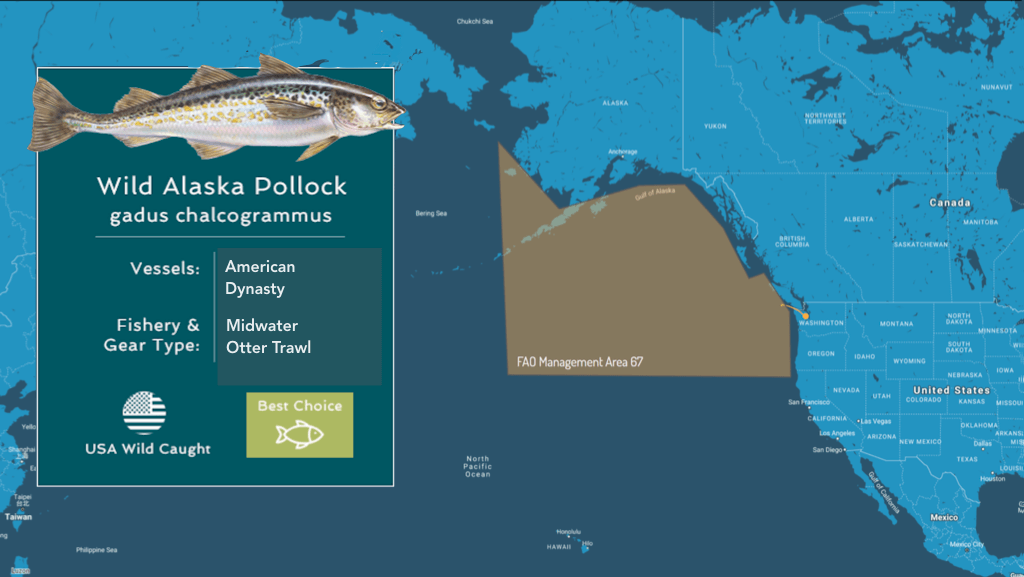
Fish: +−
Common Name: Alaska Pollock
Latin Name: Gadus chalcogrammus
Habitat: Alaska Pollock are a relatively fast-growing and short-lived species, currently representing a major biological component of the Bering Sea ecosystem. Alaska pollock dive to various depths, following diel vertical migration in pursuit of food, daily and seasonally. The species is one of the most abundant fish in Alaskan waters.
Size: Up to 20 inches, 2 pounds
Taste: Medium-firm flesh, rich taste
Fisher: +−
Vessel(s): American Dynasty
Fishery: +−
Caught: Outer Aleutian Islands, Alaska
Landed: Dutch Harbor, AK
Processed: At Sea
This fishery and species is MSC certified and stocks are healthy and abundant. In fact, The Alaska pollock has been said to be "the largest remaining source of palatable fish in the world." 85% of the fishery biomass is left water as part of healthy management.
Summary:+−
Your jerky was made from Wild Alaska Pollock from the pristine waters of the southwestern Aleutian Islands. Alaska Pollock has a mild, clean flavor profile and a choice texture. This fishery has earned distinction as the #1 rated MSC Certified fishery in the world based on effective policy, low bycatch, and other environmental metrics. The Alaska pollock has been said to be "the largest remaining source of palatable fish in the world."
INTRO TO TRACEABILITY: FISHTRAX
The Fish Trax™ system is a leading-edge electronic fishery information platform that revolutionizes the way fisheries information is collected, analyzed and shared. Envisioned initially by fishermen and scientists to track important resource data, Fish Trax™ has now expanded to serve as a tool for the seafood industry, allowing managers, scientists, regulators, and marketers to collect data and collaborate on ways to improve sustainable management practices.
HOW DID WE CHOOSE OUR FISHERIES? SCIENCE!
Our source fisheries each tell a story about the seafood sustainability that exists, and which could exist across more of the world's wild and farmed seafood if we, as consumers, demand change.
The Rockfish is a little known rockstar of the US West Coast, and a true success story in fisheries management.
The name ‘Pacific rockfish’ describes family of abundant, sustainably-managed Sebastes species common from Southern California to the Pacific Northwest and the Gulf of Alaska. After being severely depleted as a result of poor management and overfishing in the 1980’s and 1990’s (to the point that the fishery was declared a federal disaster in 2000), a new management program began in 2011 to help West Coast fishermen stay within catch limits and to avoid vulnerable species and sensitive habitat. Through the hard work of scientists, policymakers, and the fishing community, populations have rebounded, fishermen are catching rockfish, and these species are now considered a sustainable choice. At the same time, sensitive ecological areas have been protected and bycatch has reduced dramatically along the West Coast, earning most species in the fishery a “Best Choice” or “Good Alternative” listing and prompting the the Marine Stewardship Council to certify 13 species of West Coast groundfish.
Now, here’s the rub: despite the fact that they are a rich source of high-quality, sustainable protein, rockfish are currently undervalued and underutilized. Consumer interest for this noble family of fishes has yet to bounce back. In fact, only 24% of the scientifically-based West Coast quota for Pacific rockfish is caught, largely because our local rockstars have been replaced by various foreign whitefish species. As a result, some fishing communities continue to struggle, but you can help bring this success story full circle when you make the right seafood choices.
Alaska is a poster child for effective fisheries management. The Wild Alaska Pollock we source is a regenerative ocean resource from the #2 MSC certified fishery on earth and has one-fifth the carbon footprint of leading plant-based burgers (and there is published data to prove this!), with zero freshwater, agricultural inputs, or land conversion needed to produce the protein. Stocks in the fishery are healthy and abundant. In fact, The Alaska pollock has been said to be "the largest remaining source of palatable fish in the world." 85% of the fishery biomass is left water each year as part of healthy management. This fishery has 100% Fisheries Observer requirements for boats fishing, ensuring accurate reporting and management.
Neptune Snacks uses this amazing wild-caught fish to make our delicious jerky in fulfillment of our mission, which is “to innovate and incite change in the seafood industry by building a healthy, sustainable relationship with the ocean". In our eyes, the story of West Coast groundfish should serve as a model for recovery, and it is our hope that rockfish jerky is just the beginning of sweeping change in seafood. You, the consumer, can demand traceable, sustainable, high-quality seafood and be the change you want to see in our oceans.
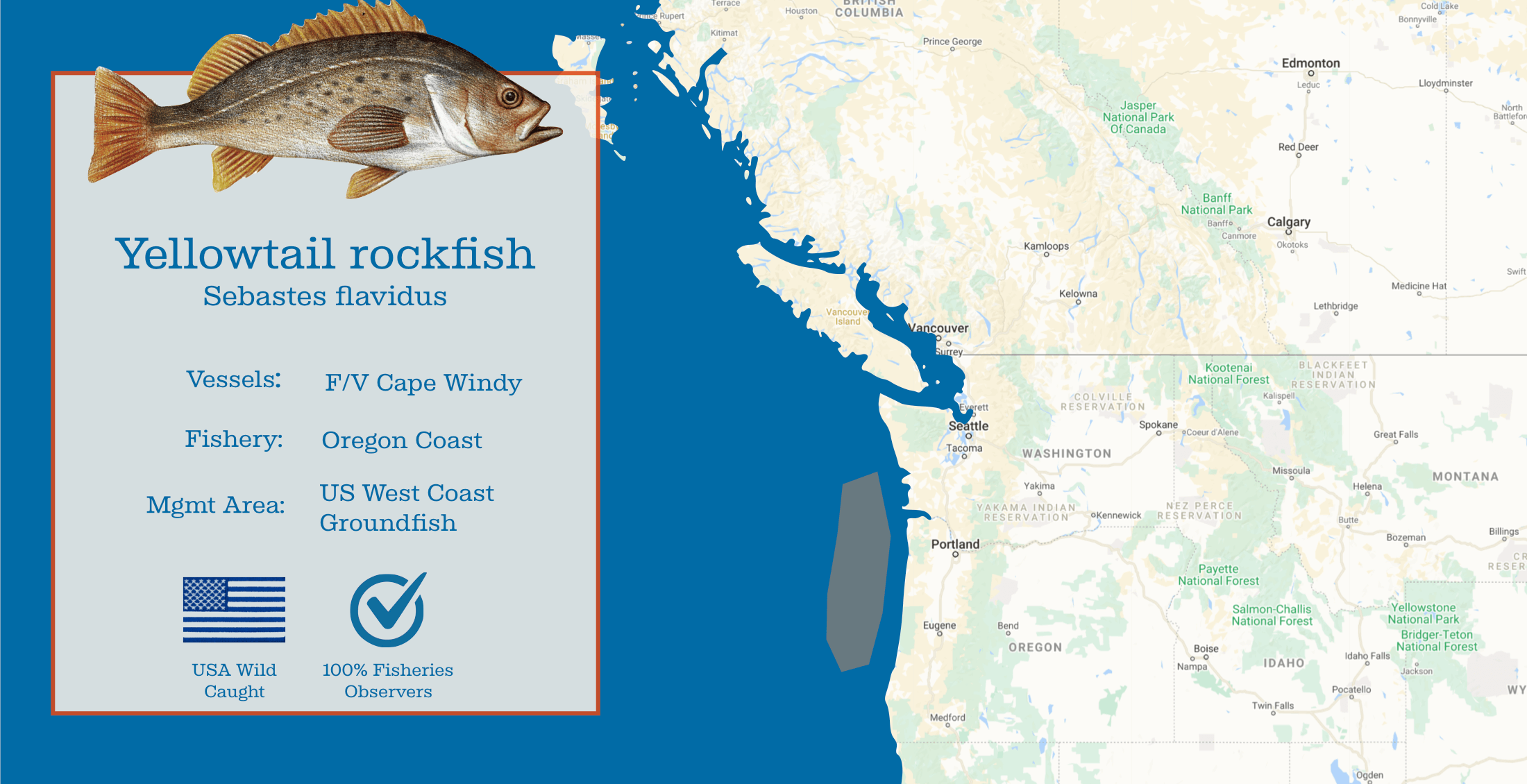
Fish: +−
Common Name: Yellowtail rockfish
Latin Name: Sebastes flavidus
Habitat: Yellowtail rockfish range from San Diego, California to the Aleutian Islands of Alaska and can be found from the surface to over 500 in depth. Yellowtail are a schooling fish that sometimes swim well off the bottom in large aggregations.
Size: Up to 26 inches
Taste: Medium-firm flesh and a mild taste
Fisher: +−
Vessel(s): F/V Cape Windy
Fishery: +−
Caught: Oregon Coast, US West Coast Groundfish Fishery
Processed: Puyallup, WA
Summary:+−
Your jerky was made from “Best Choice” Yellowtail rockfish landed in US West Coast Groundfish Fishery. This fishery has 100% Fisheries Observer requirements for boats fishing, ensuring accurate reporting and management. Some canary rockfish, which school with or near Yellowtail, are also part of this catch, and all three species are a part of the conservation and management success story in the US West Coast Groundfish fishery.
INTRO TO TRACEABILITY: FISHTRAX
The Fish Trax™ system is a leading-edge electronic fishery information platform that revolutionizes the way fisheries information is collected, analyzed and shared. Envisioned initially by fishermen and scientists to track important resource data, Fish Trax™ has now expanded to serve as a tool for the seafood industry, allowing managers, scientists, regulators, and marketers to collect data and collaborate on ways to improve sustainable management practices.
HOW DID WE CHOOSE OUR FISHERIES? SCIENCE!
Our source fisheries each tell a story about the seafood sustainability that exists, and which could exist across more of the world's wild and farmed seafood if we, as consumers, demand change.
The Rockfish is a little known rockstar of the US West Coast, and a true success story in fisheries management.
The name ‘Pacific rockfish’ describes family of abundant, sustainably-managed Sebastes species common from Southern California to the Pacific Northwest and the Gulf of Alaska. After being severely depleted as a result of poor management and overfishing in the 1980’s and 1990’s (to the point that the fishery was declared a federal disaster in 2000), a new management program began in 2011 to help West Coast fishermen stay within catch limits and to avoid vulnerable species and sensitive habitat. Through the hard work of scientists, policymakers, and the fishing community, populations have rebounded, fishermen are catching rockfish, and these species are now considered a sustainable choice. At the same time, sensitive ecological areas have been protected and bycatch has reduced dramatically along the West Coast, earning most species in the fishery a “Best Choice” or “Good Alternative” listing and prompting the the Marine Stewardship Council to certify 13 species of West Coast groundfish.
Now, here’s the rub: despite the fact that they are a rich source of high-quality, sustainable protein, rockfish are currently undervalued and underutilized. Consumer interest for this noble family of fishes has yet to bounce back. In fact, only 24% of the scientifically-based West Coast quota for Pacific rockfish is caught, largely because our local rockstars have been replaced by various foreign whitefish species. As a result, some fishing communities continue to struggle, but you can help bring this success story full circle when you make the right seafood choices.
Alaska is a poster child for effective fisheries management. The Wild Alaska Pollock we source is a regenerative ocean resource from the #2 MSC certified fishery on earth and has one-fifth the carbon footprint of leading plant-based burgers (and there is published data to prove this!), with zero freshwater, agricultural inputs, or land conversion needed to produce the protein. Stocks in the fishery are healthy and abundant. In fact, The Alaska pollock has been said to be "the largest remaining source of palatable fish in the world." 85% of the fishery biomass is left water each year as part of healthy management. This fishery has 100% Fisheries Observer requirements for boats fishing, ensuring accurate reporting and management.
Neptune Snacks uses this amazing wild-caught fish to make our delicious jerky in fulfillment of our mission, which is “to innovate and incite change in the seafood industry by building a healthy, sustainable relationship with the ocean". In our eyes, the story of West Coast groundfish should serve as a model for recovery, and it is our hope that rockfish jerky is just the beginning of sweeping change in seafood. You, the consumer, can demand traceable, sustainable, high-quality seafood and be the change you want to see in our oceans.
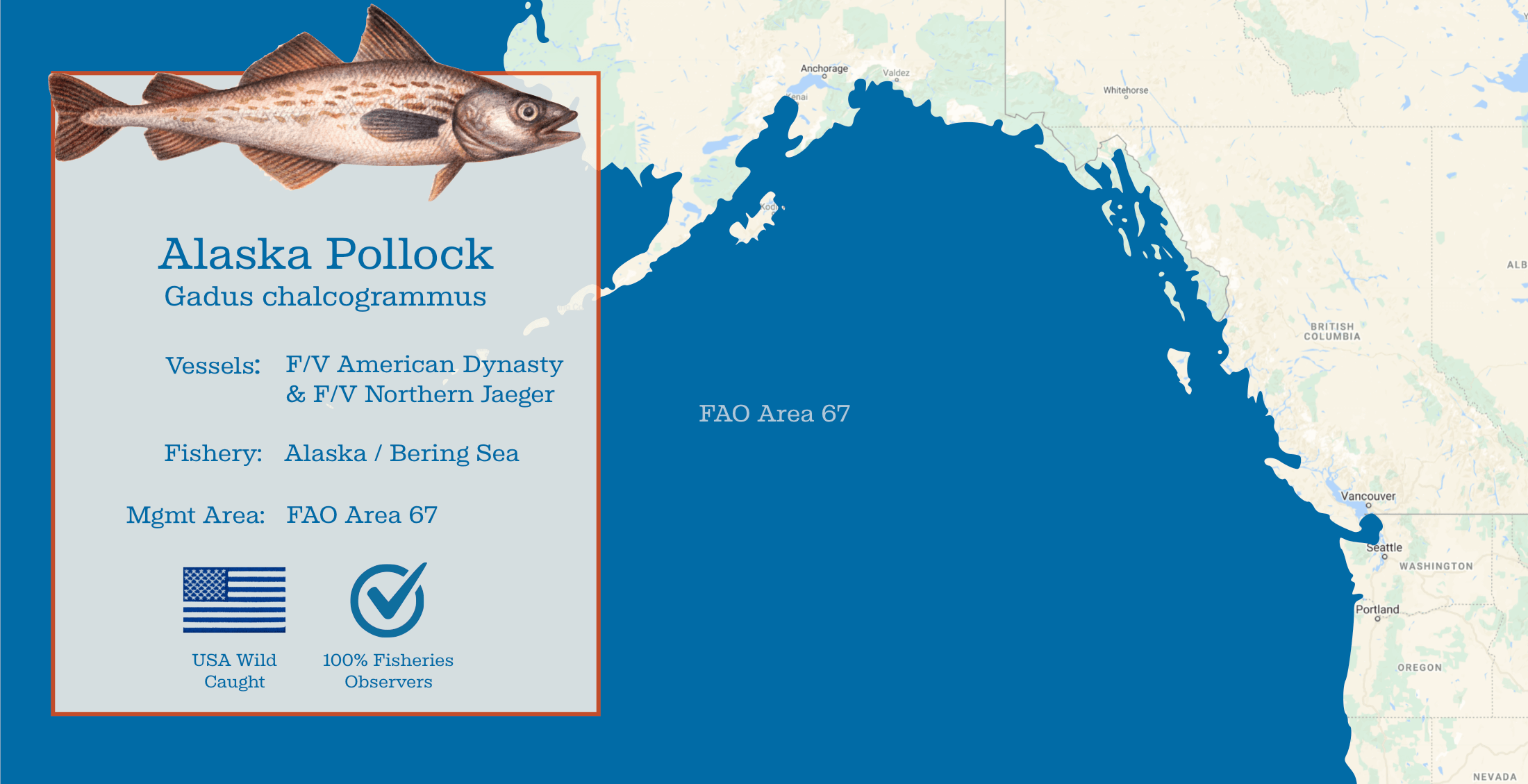
Fish: +−
Common Name: Alaska Pollock
Latin Name: Gadus chalcogrammus
Habitat: Alaska Pollock are a relatively fast-growing species, currently representing a major biological component of the Bering Sea ecosystem. Alaska pollock dive to various depths, following diel vertical migration in pursuit of food, daily and seasonally. The species is one of the most abundant fish in Alaskan waters.
Size: Up to 20 inches, 2 pounds
Taste: Medium-firm flesh, rich taste
Fisher: +−
Vessel(s): F/V Northern Jaeger, F/V American Dynasty
Fishery: +−
Caught: FAO Area 67 - Outer Aleutian Islands, Alaska
Processed: At Sea
This fishery and species is MSC certified and stocks are healthy and abundant. In fact, The Alaska pollock has been said to be "the largest remaining source of palatable fish in the world." 85% of the fishery biomass is left water as part of healthy management.
Summary:+−
Your jerky was made from Wild Alaska Pollock from the pristine waters of the southwestern Aleutian Islands. Alaska Pollock has a mild, clean flavor profile and a choice texture. This fishery has earned distinction as the #1 rated MSC Certified fishery in the world based on effective policy, low bycatch, and other environmental metrics. The Alaska pollock has been said to be "the largest remaining source of palatable fish in the world." This fishery has 100% Fisheries Observer requirements for boats fishing, ensuring accurate reporting and management.
INTRO TO TRACEABILITY: FISHTRAX
The Fish Trax™ system is a leading-edge electronic fishery information platform that revolutionizes the way fisheries information is collected, analyzed and shared. Envisioned initially by fishermen and scientists to track important resource data, Fish Trax™ has now expanded to serve as a tool for the seafood industry, allowing managers, scientists, regulators, and marketers to collect data and collaborate on ways to improve sustainable management practices.
HOW DID WE CHOOSE OUR FISHERIES? SCIENCE!
Our source fisheries each tell a story about the seafood sustainability that exists, and which could exist across more of the world's wild and farmed seafood if we, as consumers, demand change.
The Rockfish is a little known rockstar of the US West Coast, and a true success story in fisheries management.
The name ‘Pacific rockfish’ describes family of abundant, sustainably-managed Sebastes species common from Southern California to the Pacific Northwest and the Gulf of Alaska. After being severely depleted as a result of poor management and overfishing in the 1980’s and 1990’s (to the point that the fishery was declared a federal disaster in 2000), a new management program began in 2011 to help West Coast fishermen stay within catch limits and to avoid vulnerable species and sensitive habitat. Through the hard work of scientists, policymakers, and the fishing community, populations have rebounded, fishermen are catching rockfish, and these species are now considered a sustainable choice. At the same time, sensitive ecological areas have been protected and bycatch has reduced dramatically along the West Coast, earning most species in the fishery a “Best Choice” or “Good Alternative” listing and prompting the the Marine Stewardship Council to certify 13 species of West Coast groundfish.
Now, here’s the rub: despite the fact that they are a rich source of high-quality, sustainable protein, rockfish are currently undervalued and underutilized. Consumer interest for this noble family of fishes has yet to bounce back. In fact, only 24% of the scientifically-based West Coast quota for Pacific rockfish is caught, largely because our local rockstars have been replaced by various foreign whitefish species. As a result, some fishing communities continue to struggle, but you can help bring this success story full circle when you make the right seafood choices.
Alaska is a poster child for effective fisheries management. The Wild Alaska Pollock we source is a regenerative ocean resource from the #2 MSC certified fishery on earth and has one-fifth the carbon footprint of leading plant-based burgers (and there is published data to prove this!), with zero freshwater, agricultural inputs, or land conversion needed to produce the protein. Stocks in the fishery are healthy and abundant. In fact, The Alaska pollock has been said to be "the largest remaining source of palatable fish in the world." 85% of the fishery biomass is left water each year as part of healthy management. This fishery has 100% Fisheries Observer requirements for boats fishing, ensuring accurate reporting and management.
Neptune Snacks uses this amazing wild-caught fish to make our delicious jerky in fulfillment of our mission, which is “to innovate and incite change in the seafood industry by building a healthy, sustainable relationship with the ocean". In our eyes, the story of West Coast groundfish should serve as a model for recovery, and it is our hope that rockfish jerky is just the beginning of sweeping change in seafood. You, the consumer, can demand traceable, sustainable, high-quality seafood and be the change you want to see in our oceans.

Fish: +−
Common Name: Alaska Pollock
Latin Name: Gadus chalcogrammus
Habitat: Alaska Pollock are a relatively fast-growing species, currently representing a major biological component of the Bering Sea ecosystem. Alaska pollock dive to various depths, following diel vertical migration in pursuit of food, daily and seasonally. The species is one of the most abundant fish in Alaskan waters.
Size: Up to 20 inches, 2 pounds
Taste: Medium-firm flesh, rich taste
Fisher: +−
Vessel(s): F/V American Dynasty
Fishery: +−
Caught: FAO Area 67 - Outer Aleutian Islands, Alaska
Processed: At Sea
This fishery and species is MSC certified and stocks are healthy and abundant. In fact, The Alaska pollock has been said to be "the largest remaining source of palatable fish in the world." 85% of the fishery biomass is left water as part of healthy management. This fishery has 100% Fisheries Observer requirements for boats fishing, ensuring accurate reporting and management.
Summary:+−
Your jerky was made from Wild Alaska Pollock from the pristine waters of the southwestern Aleutian Islands. Alaska Pollock has a mild, clean flavor profile and a choice texture. This fishery has earned distinction as the #1 rated MSC Certified fishery in the world based on effective policy, low bycatch, and other environmental metrics. The Alaska pollock has been said to be "the largest remaining source of palatable fish in the world."
INTRO TO TRACEABILITY: FISHTRAX
The Fish Trax™ system is a leading-edge electronic fishery information platform that revolutionizes the way fisheries information is collected, analyzed and shared. Envisioned initially by fishermen and scientists to track important resource data, Fish Trax™ has now expanded to serve as a tool for the seafood industry, allowing managers, scientists, regulators, and marketers to collect data and collaborate on ways to improve sustainable management practices.
HOW DID WE CHOOSE OUR FISHERIES? SCIENCE!
Our source fisheries each tell a story about the seafood sustainability that exists, and which could exist across more of the world's wild and farmed seafood if we, as consumers, demand change.
The Rockfish is a little known rockstar of the US West Coast, and a true success story in fisheries management.
The name ‘Pacific rockfish’ describes family of abundant, sustainably-managed Sebastes species common from Southern California to the Pacific Northwest and the Gulf of Alaska. After being severely depleted as a result of poor management and overfishing in the 1980’s and 1990’s (to the point that the fishery was declared a federal disaster in 2000), a new management program began in 2011 to help West Coast fishermen stay within catch limits and to avoid vulnerable species and sensitive habitat. Through the hard work of scientists, policymakers, and the fishing community, populations have rebounded, fishermen are catching rockfish, and these species are now considered a sustainable choice. At the same time, sensitive ecological areas have been protected and bycatch has reduced dramatically along the West Coast, earning most species in the fishery a “Best Choice” or “Good Alternative” listing and prompting the the Marine Stewardship Council to certify 13 species of West Coast groundfish.
Now, here’s the rub: despite the fact that they are a rich source of high-quality, sustainable protein, rockfish are currently undervalued and underutilized. Consumer interest for this noble family of fishes has yet to bounce back. In fact, only 24% of the scientifically-based West Coast quota for Pacific rockfish is caught, largely because our local rockstars have been replaced by various foreign whitefish species. As a result, some fishing communities continue to struggle, but you can help bring this success story full circle when you make the right seafood choices.
Alaska is a poster child for effective fisheries management. The Wild Alaska Pollock we source is a regenerative ocean resource from the #2 MSC certified fishery on earth and has one-fifth the carbon footprint of leading plant-based burgers (and there is published data to prove this!), with zero freshwater, agricultural inputs, or land conversion needed to produce the protein. Stocks in the fishery are healthy and abundant. In fact, The Alaska pollock has been said to be "the largest remaining source of palatable fish in the world." 85% of the fishery biomass is left water each year as part of healthy management. This fishery has 100% Fisheries Observer requirements for boats fishing, ensuring accurate reporting and management.
Neptune Snacks uses this amazing wild-caught fish to make our delicious jerky in fulfillment of our mission, which is “to innovate and incite change in the seafood industry by building a healthy, sustainable relationship with the ocean". In our eyes, the story of West Coast groundfish should serve as a model for recovery, and it is our hope that rockfish jerky is just the beginning of sweeping change in seafood. You, the consumer, can demand traceable, sustainable, high-quality seafood and be the change you want to see in our oceans.

Fish: +−
Common Name: Yellowtail rockfish
Latin Name: Sebastes flavidus
Habitat: Yellowtail rockfish range from San Diego, California to the Aleutian Islands of Alaska and can be found from the surface to over 500 in depth. Yellowtail are a schooling fish that sometimes swim well off the bottom in large aggregations.
Size: Up to 26 inches
Taste: Up to 26 inches
Fisher: +−
Vessel(s): F/V Raven and F/V Arctic Ram
Fishery: +−
Caught: Oregon Coast, US West Coast Groundfish Fishery
Processed: Puyallup, WA
Summary:+−
Your jerky was made from “Best Choice” Yellowtail rockfish landed in US West Coast Groundfish Fishery. These fish were bycatch caught by several local mid-water trawl fishers targeting Pacific whiting, and recorded in the quota. This fishery has 100% Fisheries Observer requirements for boats fishing, ensuring accurate reporting and management. Some Widow and canary rockfish, which school with or near Yellowtail, are also part of this catch, and all three species are a part of the conservation and management success story in the US West Coast Groundfish fishery.
INTRO TO TRACEABILITY: FISHTRAX
The Fish Trax™ system is a leading-edge electronic fishery information platform that revolutionizes the way fisheries information is collected, analyzed and shared. Envisioned initially by fishermen and scientists to track important resource data, Fish Trax™ has now expanded to serve as a tool for the seafood industry, allowing managers, scientists, regulators, and marketers to collect data and collaborate on ways to improve sustainable management practices.
HOW DID WE CHOOSE OUR FISHERIES? SCIENCE!
Our source fisheries each tell a story about the seafood sustainability that exists, and which could exist across more of the world's wild and farmed seafood if we, as consumers, demand change.
The Rockfish is a little known rockstar of the US West Coast, and a true success story in fisheries management.
The name ‘Pacific rockfish’ describes family of abundant, sustainably-managed Sebastes species common from Southern California to the Pacific Northwest and the Gulf of Alaska. After being severely depleted as a result of poor management and overfishing in the 1980’s and 1990’s (to the point that the fishery was declared a federal disaster in 2000), a new management program began in 2011 to help West Coast fishermen stay within catch limits and to avoid vulnerable species and sensitive habitat. Through the hard work of scientists, policymakers, and the fishing community, populations have rebounded, fishermen are catching rockfish, and these species are now considered a sustainable choice. At the same time, sensitive ecological areas have been protected and bycatch has reduced dramatically along the West Coast, earning most species in the fishery a “Best Choice” or “Good Alternative” listing and prompting the the Marine Stewardship Council to certify 13 species of West Coast groundfish.
Now, here’s the rub: despite the fact that they are a rich source of high-quality, sustainable protein, rockfish are currently undervalued and underutilized. Consumer interest for this noble family of fishes has yet to bounce back. In fact, only 24% of the scientifically-based West Coast quota for Pacific rockfish is caught, largely because our local rockstars have been replaced by various foreign whitefish species. As a result, some fishing communities continue to struggle, but you can help bring this success story full circle when you make the right seafood choices.
Alaska is a poster child for effective fisheries management. The Wild Alaska Pollock we source is a regenerative ocean resource from the #2 MSC certified fishery on earth and has one-fifth the carbon footprint of leading plant-based burgers (and there is published data to prove this!), with zero freshwater, agricultural inputs, or land conversion needed to produce the protein. Stocks in the fishery are healthy and abundant. In fact, The Alaska pollock has been said to be "the largest remaining source of palatable fish in the world." 85% of the fishery biomass is left water each year as part of healthy management. This fishery has 100% Fisheries Observer requirements for boats fishing, ensuring accurate reporting and management.
Neptune Snacks uses this amazing wild-caught fish to make our delicious jerky in fulfillment of our mission, which is “to innovate and incite change in the seafood industry by building a healthy, sustainable relationship with the ocean". In our eyes, the story of West Coast groundfish should serve as a model for recovery, and it is our hope that rockfish jerky is just the beginning of sweeping change in seafood. You, the consumer, can demand traceable, sustainable, high-quality seafood and be the change you want to see in our oceans.
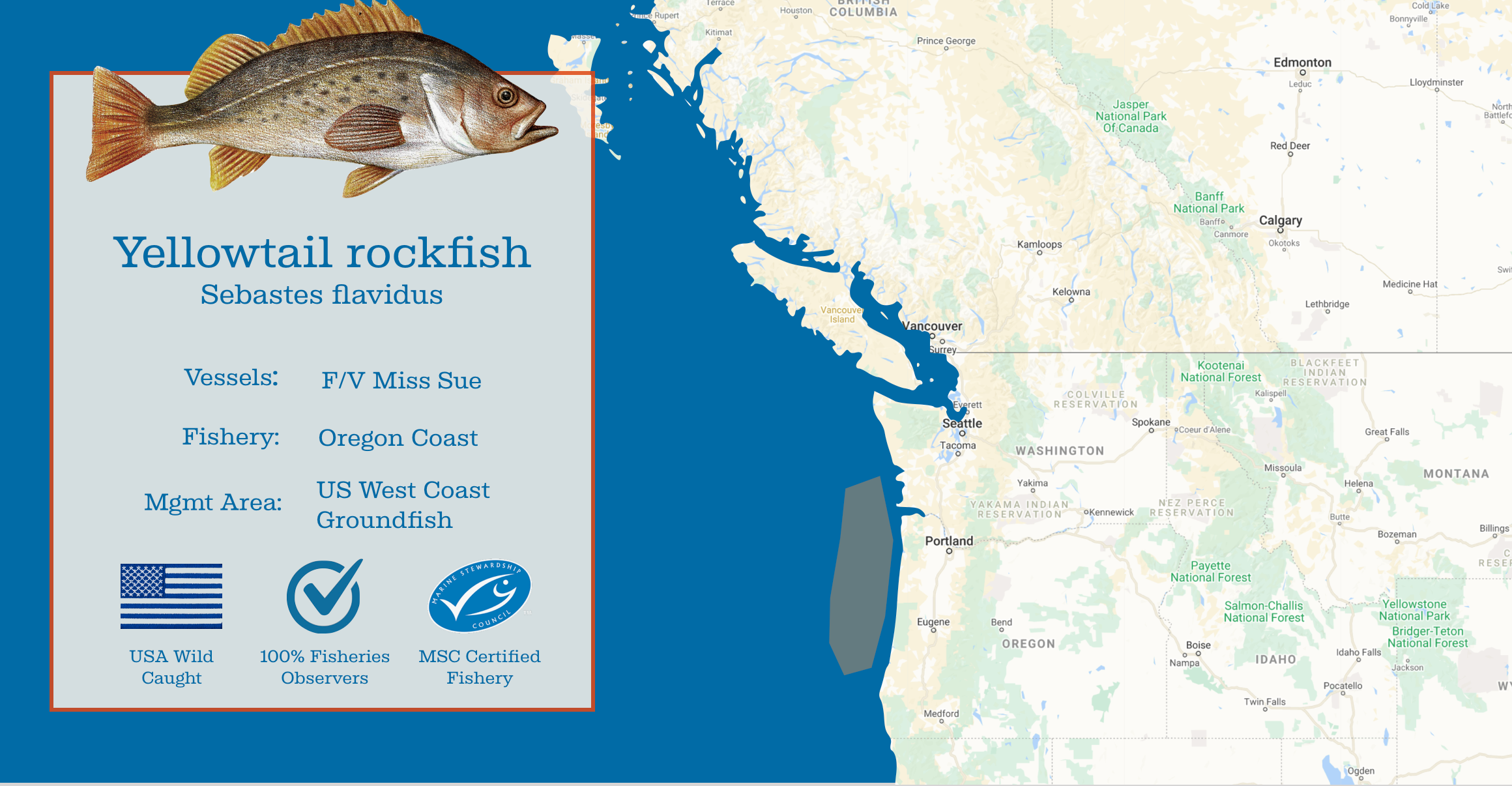
Fish: +−
Common Name: Yellowtail rockfish
Latin Name: Sebastes flavidus
Habitat: Yellowtail rockfish range from San Diego, California to the Aleutian Islands of Alaska and can be found from the surface to over 500 in depth. Yellowtail are a schooling fish that sometimes swim well off the bottom in large aggregations.
Size: Up to 26 inches
Taste: Medium-firm flesh and a mild taste
Fisher: +−
Vessel(s): F/V Miss Sue
Fishery: +−
Caught: Oregon Coast, US West Coast Groundfish Fishery
Processed: Seattle, WA
Summary:+−
Your jerky was made from “Best Choice” Yellowtail rockfish landed in Limited Entry US West Coast Groundfish Fishery. These fillets were ‘undervalued’ for being the wrong shape or weight to meet specs for orders, but are of the same premium quality as rockfish going to white-tablecloth restaurants around the country. This fishery has 100% Fisheries Observer requirements, ensuring accurate reporting and management. We source US West Coast rockfish for the sustainability and quality attributes stated above, and because the rapid turnaround of the fishery to its current state (after depletion in the 1980s and 1990s) was made uniquely made possible through the collaboration of fishermen and environmentalists who spent years refining a long-term fishing plan. This story is considered one of the greatest conservation and management success stories in wild fisheries.
INTRO TO TRACEABILITY: FISHTRAX
The Fish Trax™ system is a leading-edge electronic fishery information platform that revolutionizes the way fisheries information is collected, analyzed and shared. Envisioned initially by fishermen and scientists to track important resource data, Fish Trax™ has now expanded to serve as a tool for the seafood industry, allowing managers, scientists, regulators, and marketers to collect data and collaborate on ways to improve sustainable management practices.
HOW DID WE CHOOSE OUR FISHERIES? SCIENCE!
Our source fisheries each tell a story about the seafood sustainability that exists, and which could exist across more of the world's wild and farmed seafood if we, as consumers, demand change.
The Rockfish is a little known rockstar of the US West Coast, and a true success story in fisheries management.
The name ‘Pacific rockfish’ describes family of abundant, sustainably-managed Sebastes species common from Southern California to the Pacific Northwest and the Gulf of Alaska. After being severely depleted as a result of poor management and overfishing in the 1980’s and 1990’s (to the point that the fishery was declared a federal disaster in 2000), a new management program began in 2011 to help West Coast fishermen stay within catch limits and to avoid vulnerable species and sensitive habitat. Through the hard work of scientists, policymakers, and the fishing community, populations have rebounded, fishermen are catching rockfish, and these species are now considered a sustainable choice. At the same time, sensitive ecological areas have been protected and bycatch has reduced dramatically along the West Coast, earning most species in the fishery a “Best Choice” or “Good Alternative” listing and prompting the the Marine Stewardship Council to certify 13 species of West Coast groundfish.
Now, here’s the rub: despite the fact that they are a rich source of high-quality, sustainable protein, rockfish are currently undervalued and underutilized. Consumer interest for this noble family of fishes has yet to bounce back. In fact, only 24% of the scientifically-based West Coast quota for Pacific rockfish is caught, largely because our local rockstars have been replaced by various foreign whitefish species. As a result, some fishing communities continue to struggle, but you can help bring this success story full circle when you make the right seafood choices.
Alaska is a poster child for effective fisheries management. The Wild Alaska Pollock we source is a regenerative ocean resource from the #2 MSC certified fishery on earth and has one-fifth the carbon footprint of leading plant-based burgers (and there is published data to prove this!), with zero freshwater, agricultural inputs, or land conversion needed to produce the protein. Stocks in the fishery are healthy and abundant. In fact, The Alaska pollock has been said to be "the largest remaining source of palatable fish in the world." 85% of the fishery biomass is left water each year as part of healthy management. This fishery has 100% Fisheries Observer requirements for boats fishing, ensuring accurate reporting and management.
Neptune Snacks uses this amazing wild-caught fish to make our delicious jerky in fulfillment of our mission, which is “to innovate and incite change in the seafood industry by building a healthy, sustainable relationship with the ocean". In our eyes, the story of West Coast groundfish should serve as a model for recovery, and it is our hope that rockfish jerky is just the beginning of sweeping change in seafood. You, the consumer, can demand traceable, sustainable, high-quality seafood and be the change you want to see in our oceans.
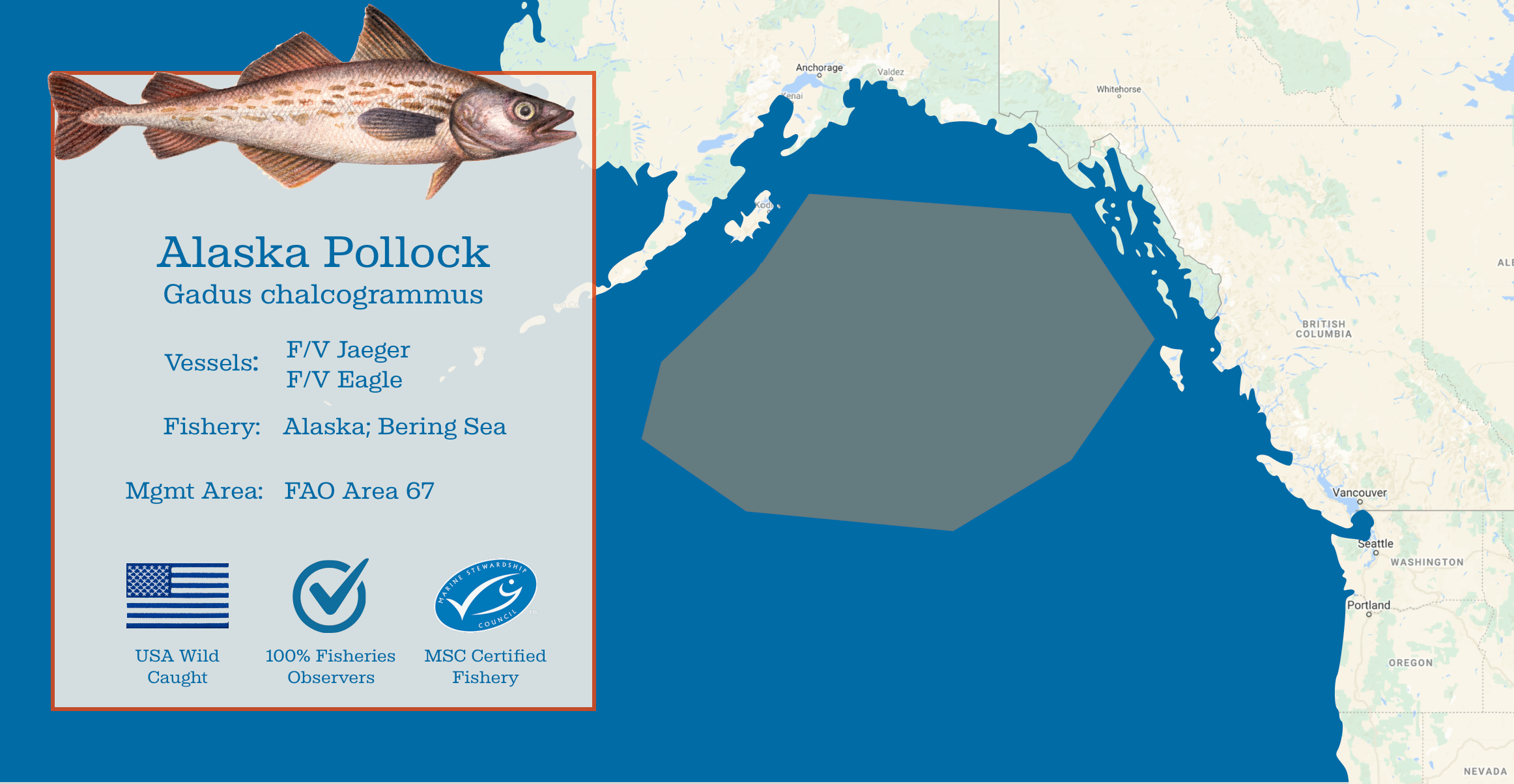
Fish: +−
Common Name: Alaska Pollock
Latin Name: Gadus chalcogrammus
Habitat: Alaska Pollock are a relatively fast-growing species, currently representing a major biological component of the Bering Sea ecosystem. Alaska pollock dive to various depths, following diel vertical migration in pursuit of food, daily and seasonally. The species is one of the most abundant fish in Alaskan waters.
Size: Up to 20 inches, 2 pounds
Taste: Bright white medium-firm flesh, mild taste
Fisher: +−
Vessel(s): F/V Jaeger, F/V Eagle
Fishery: +−
Caught: FAO Area 67 - Outer Aleutian Islands, Alaska
Processed: At Sea
This fishery is the #2 rated MSC certified fishery on earth. Stocks are considered healthy and abundant. In fact, The Alaska pollock has been said to be "the largest remaining source of palatable fish in the world." 85% of the fishery biomass is left water each year as part of healthy management. This fishery has 100% Fisheries Observer requirements for boats fishing, ensuring accurate reporting and management.
Summary:+−
Your jerky was made from Wild Alaska Pollock from the pristine waters of the southwestern Aleutian Islands. Alaska Pollock has a mild, clean flavor profile and a choice texture. This fishery has earned distinction as the #2 rated MSC Certified fishery in the world based on effective policy, low bycatch, and other environmental metrics. A recent third party Life Cycle Analysis done on the fishery demonstrated that it has one of the lowest carbon footprints of any protein available. Wild Alaska Pollock’s Carbon footprint is a fraction that of tofu and plant-based burger, and 3% the carbon of conventional beef, without the use of freshwater or agricultural inputs.
INTRO TO TRACEABILITY: FISHTRAX
The Fish Trax™ system is a leading-edge electronic fishery information platform that revolutionizes the way fisheries information is collected, analyzed and shared. Envisioned initially by fishermen and scientists to track important resource data, Fish Trax™ has now expanded to serve as a tool for the seafood industry, allowing managers, scientists, regulators, and marketers to collect data and collaborate on ways to improve sustainable management practices.
HOW DID WE CHOOSE OUR FISHERIES? SCIENCE!
Our source fisheries each tell a story about the seafood sustainability that exists, and which could exist across more of the world's wild and farmed seafood if we, as consumers, demand change.
The Rockfish is a little known rockstar of the US West Coast, and a true success story in fisheries management.
The name ‘Pacific rockfish’ describes family of abundant, sustainably-managed Sebastes species common from Southern California to the Pacific Northwest and the Gulf of Alaska. After being severely depleted as a result of poor management and overfishing in the 1980’s and 1990’s (to the point that the fishery was declared a federal disaster in 2000), a new management program began in 2011 to help West Coast fishermen stay within catch limits and to avoid vulnerable species and sensitive habitat. Through the hard work of scientists, policymakers, and the fishing community, populations have rebounded, fishermen are catching rockfish, and these species are now considered a sustainable choice. At the same time, sensitive ecological areas have been protected and bycatch has reduced dramatically along the West Coast, earning most species in the fishery a “Best Choice” or “Good Alternative” listing and prompting the the Marine Stewardship Council to certify 13 species of West Coast groundfish.
Now, here’s the rub: despite the fact that they are a rich source of high-quality, sustainable protein, rockfish are currently undervalued and underutilized. Consumer interest for this noble family of fishes has yet to bounce back. In fact, only 24% of the scientifically-based West Coast quota for Pacific rockfish is caught, largely because our local rockstars have been replaced by various foreign whitefish species. As a result, some fishing communities continue to struggle, but you can help bring this success story full circle when you make the right seafood choices.
Alaska is a poster child for effective fisheries management. The Wild Alaska Pollock we source is a regenerative ocean resource from the #2 MSC certified fishery on earth and has one-fifth the carbon footprint of leading plant-based burgers (and there is published data to prove this!), with zero freshwater, agricultural inputs, or land conversion needed to produce the protein. Stocks in the fishery are healthy and abundant. In fact, The Alaska pollock has been said to be "the largest remaining source of palatable fish in the world." 85% of the fishery biomass is left water each year as part of healthy management. This fishery has 100% Fisheries Observer requirements for boats fishing, ensuring accurate reporting and management.
Neptune Snacks uses this amazing wild-caught fish to make our delicious jerky in fulfillment of our mission, which is “to innovate and incite change in the seafood industry by building a healthy, sustainable relationship with the ocean". In our eyes, the story of West Coast groundfish should serve as a model for recovery, and it is our hope that rockfish jerky is just the beginning of sweeping change in seafood. You, the consumer, can demand traceable, sustainable, high-quality seafood and be the change you want to see in our oceans.
INTRO TO TRACEABILITY: FISHTRAX
The Fish Trax™ system is a leading-edge electronic fishery information platform that revolutionizes the way fisheries information is collected, analyzed and shared. Envisioned initially by fishermen and scientists to track important resource data, Fish Trax™ has now expanded to serve as a tool for the seafood industry, allowing managers, scientists, regulators, and marketers to collect data and collaborate on ways to improve sustainable management practices.
HOW DID WE CHOOSE OUR FISHERIES? SCIENCE!
Our source fisheries each tell a story about the seafood sustainability that exists, and which could exist across more of the world's wild and farmed seafood if we, as consumers, demand change.
The Rockfish is a little known rockstar of the US West Coast, and a true success story in fisheries management.
The name ‘Pacific rockfish’ describes family of abundant, sustainably-managed Sebastes species common from Southern California to the Pacific Northwest and the Gulf of Alaska. After being severely depleted as a result of poor management and overfishing in the 1980’s and 1990’s (to the point that the fishery was declared a federal disaster in 2000), a new management program began in 2011 to help West Coast fishermen stay within catch limits and to avoid vulnerable species and sensitive habitat. Through the hard work of scientists, policymakers, and the fishing community, populations have rebounded, fishermen are catching rockfish, and these species are now considered a sustainable choice. At the same time, sensitive ecological areas have been protected and bycatch has reduced dramatically along the West Coast, earning most species in the fishery a “Best Choice” or “Good Alternative” listing and prompting the the Marine Stewardship Council to certify 13 species of West Coast groundfish.
Now, here’s the rub: despite the fact that they are a rich source of high-quality, sustainable protein, rockfish are currently undervalued and underutilized. Consumer interest for this noble family of fishes has yet to bounce back. In fact, only 24% of the scientifically-based West Coast quota for Pacific rockfish is caught, largely because our local rockstars have been replaced by various foreign whitefish species. As a result, some fishing communities continue to struggle, but you can help bring this success story full circle when you make the right seafood choices.
Alaska is a poster child for effective fisheries management. The Wild Alaska Pollock we source is a regenerative ocean resource from the #2 MSC certified fishery on earth and has one-fifth the carbon footprint of leading plant-based burgers (and there is published data to prove this!), with zero freshwater, agricultural inputs, or land conversion needed to produce the protein. Stocks in the fishery are healthy and abundant. In fact, The Alaska pollock has been said to be "the largest remaining source of palatable fish in the world." 85% of the fishery biomass is left water each year as part of healthy management. This fishery has 100% Fisheries Observer requirements for boats fishing, ensuring accurate reporting and management.
Neptune Snacks uses this amazing wild-caught fish to make our delicious jerky in fulfillment of our mission, which is “to innovate and incite change in the seafood industry by building a healthy, sustainable relationship with the ocean". In our eyes, the story of West Coast groundfish should serve as a model for recovery, and it is our hope that rockfish jerky is just the beginning of sweeping change in seafood. You, the consumer, can demand traceable, sustainable, high-quality seafood and be the change you want to see in our oceans.
Uh oh, we didn't recognize that batch date! Lost at sea...? Please check your product try again with a different code.
Don't have a batch? Well, let's correct that. Shop now!
